Great choice! Your favorites are temporarily saved for this session. Sign in to save them permanently, access them on any device, and receive relevant alerts.
- Sailboat Guide
Pacific 30 is a 29 ′ 11 ″ / 9.1 m monohull sailboat designed by Raymond Richards and built by J D Marine (CAN) starting in 1962.

Rig and Sails
Auxilary power, accomodations, calculations.
The theoretical maximum speed that a displacement hull can move efficiently through the water is determined by it's waterline length and displacement. It may be unable to reach this speed if the boat is underpowered or heavily loaded, though it may exceed this speed given enough power. Read more.
Classic hull speed formula:
Hull Speed = 1.34 x √LWL
Max Speed/Length ratio = 8.26 ÷ Displacement/Length ratio .311 Hull Speed = Max Speed/Length ratio x √LWL
Sail Area / Displacement Ratio
A measure of the power of the sails relative to the weight of the boat. The higher the number, the higher the performance, but the harder the boat will be to handle. This ratio is a "non-dimensional" value that facilitates comparisons between boats of different types and sizes. Read more.
SA/D = SA ÷ (D ÷ 64) 2/3
- SA : Sail area in square feet, derived by adding the mainsail area to 100% of the foretriangle area (the lateral area above the deck between the mast and the forestay).
- D : Displacement in pounds.
Ballast / Displacement Ratio
A measure of the stability of a boat's hull that suggests how well a monohull will stand up to its sails. The ballast displacement ratio indicates how much of the weight of a boat is placed for maximum stability against capsizing and is an indicator of stiffness and resistance to capsize.
Ballast / Displacement * 100
Displacement / Length Ratio
A measure of the weight of the boat relative to it's length at the waterline. The higher a boat’s D/L ratio, the more easily it will carry a load and the more comfortable its motion will be. The lower a boat's ratio is, the less power it takes to drive the boat to its nominal hull speed or beyond. Read more.
D/L = (D ÷ 2240) ÷ (0.01 x LWL)³
- D: Displacement of the boat in pounds.
- LWL: Waterline length in feet
Comfort Ratio
This ratio assess how quickly and abruptly a boat’s hull reacts to waves in a significant seaway, these being the elements of a boat’s motion most likely to cause seasickness. Read more.
Comfort ratio = D ÷ (.65 x (.7 LWL + .3 LOA) x Beam 1.33 )
- D: Displacement of the boat in pounds
- LOA: Length overall in feet
- Beam: Width of boat at the widest point in feet
Capsize Screening Formula
This formula attempts to indicate whether a given boat might be too wide and light to readily right itself after being overturned in extreme conditions. Read more.
CSV = Beam ÷ ³√(D / 64)
Dimensions, in part, from ‘Sailing Craft in Canada’; (1972); by Cliff Newman. Number built is unknown but is thought to exceed 50. Mostly seen in the Pacific Northwest (USA).
Embed this page on your own website by copying and pasting this code.
- About Sailboat Guide
©2024 Sea Time Tech, LLC
This site is protected by reCAPTCHA and the Google Privacy Policy and Terms of Service apply.
The Pacific 30 is a 30.0ft masthead sloop designed by Ray Richards and built in fiberglass since 1962.
The Pacific 30 is a heavy sailboat which is under powered. It is very stable / stiff and has an excellent righting capability if capsized. It is best suited as a bluewater cruising boat. The fuel capacity is originally very small. There is a very short water supply range.
Pacific 30 for sale elsewhere on the web:

Main features
| Model | Pacific 30 | ||
| Length | 30 ft | ||
| Beam | 8.83 ft | ||
| Draft | 4.83 ft | ||
| Country | ?? | ||
| Estimated price | $ 0 | ?? |
Login or register to personnalize this screen.
You will be able to pin external links of your choice.

See how Sailboatlab works in video
| Sail area / displ. | 11.72 | ||
| Ballast / displ. | 43.01 % | ||
| Displ. / length | 300.33 | ||
| Comfort ratio | 30.61 | ||
| Capsize | 1.68 |
| Hull type | Monohull fin keel | ||
| Construction | Fiberglass | ||
| Waterline length | 24 ft | ||
| Maximum draft | 4.83 ft | ||
| Displacement | 9300 lbs | ||
| Ballast | 4000 lbs | ||
| Hull speed | 6.56 knots |

We help you build your own hydraulic steering system - Lecomble & Schmitt
| Rigging | Masthead Sloop | ||
| Sail area (100%) | 323 sq.ft | ||
| Air draft | 41 ft | ||
| Sail area fore | 154 sq.ft | ||
| Sail area main | 168.75 sq.ft | ||
| I | 30.80 ft | ||
| J | 10 ft | ||
| P | 27 ft | ||
| E | 12.50 ft |
| Nb engines | 1 | ||
| Total power | 12 HP | ||
| Fuel capacity | 15 gals |
Accommodations
| Water capacity | 36 gals | ||
| Headroom | 0 ft | ||
| Nb of cabins | 0 | ||
| Nb of berths | 0 | ||
| Nb heads | 0 |
Builder data
| Builder | ?? | ||
| Designer | Ray Richards | ||
| First built | 1962 | ||
| Last built | 0 | ?? | |
| Number built | 0 | ?? |
Modal Title
The content of your modal.
Personalize your sailboat data sheet

5 Best Liveaboard Bluewater Sailboats

Liveaboard bluewater sailboats are both comfortable to live on and capable of making long, offshore ocean voyages.
The best liveaboard bluewater sailboats must strike a balance between comfort and seakeeping abilities. These boats are generally heavy and stable and roomy enough to spend time in. They must also include the necessary hardware to make cooking, sleeping, and bathing possible in choppy conditions.
Table of contents
Bluewater Liveaboard Sailboat Design
What makes a good bluewater liveaboard sailboat , and how is it different from a coastal cruiser? There are a few aspects of purpose-built bluewater sailboats that make them different from most production vessels. The first and (possibly) most important is the hull design.
The classic bluewater sailboat hull shape features a long, deep, full keel. The keel acts as a hydroplane and keeps the boat stable on course in all sea conditions. Deep keel sailboats aren't the only kind of bluewater-capable vessels, but they're a tried and tested design.
Other vessels gain stability from having a wide beam. Beamy sailboats are far more comfortable in rolling seas, as they tend to buffett and pitch much less than leaner, narrow boats. Most ideal liveaboard bluewater sailboats balance length and beam carefully to make the most of the space and hull shape.
Space is another important quality to consider when choosing the best bluewater liveaboard sailboat. Interior space comes first, as living quarters are a key element of comfort.
Cockpit space should also be considered, especially if more than one person comes aboard. Most liveaboard bluewater sailboats sacrifice cockpit space for cabin space.
A comfortable liveaboard sailboat should include several amenities, including a head (toilet), a shower, two sinks, a galley with a stove, an icebox, a place to eat, and a place to sleep. Ideally, the dining area is separate from the primary sleeping area.
A separate chart table is ideal as well because it keeps food and clutter away from important navigational equipment. A chart table is less important on liveaboard sailboats that spend the majority of their time docked. That said, the chart table functions well as a spot for a microwave, toaster oven, or TV when you're not underway.
A separate forward V-berth, known as a master cabin, is a big plus on liveaboard boats. Separating the sleeping area from the rest of the cabin can increase comfort and coziness.
However, on a bluewater sailboat, a side berth near the hatch is essential as well. This is because you may need to quickly take control of the vessel after waking up, and it's best to sleep close to the helm.
Power and Water
Power and water shouldn't be overlooked when choosing a bluewater liveaboard. Many liveaboards spend most of their time docked and hooked up to shore power, water, and sewage. But bluewater liveaboards are designed for cruising, which means everything must be self-contained.
The best bluewater sailboats have sufficient freshwater storage tanks for several weeks on the water. Some have desalination (water maker) machines, which require electricity to run.
Solar panels are an excellent option for power generation, and they can be installed on almost any sailboat.
But all bluewater sailboats should have battery banks and a gasoline or diesel generator built into the system. On many vessels, the inboard engine also functions as a generator.
Safety is an essential factor to consider when choosing a cruising sailboat , especially if it doubles as your primary residence. Basic safety equipment such as bilge pumps and radios should be maintained and tested regularly. Backups and spare parts should also be kept aboard.
Other safety features, such as watertight hatches, can keep your cabin safe and dry during inclement weather. Self-draining cockpits are helpful when sailing offshore, as spray and waves drain from the exposed cockpit without the use of electric or mechanical pumps. If the drain ports are kept clean, no bailing is ever necessary.
Radar is another useful safety feature that, while not mandatory, can keep you in-the-know and alert you to the presence of nearby ships. Radar is especially useful at night, as the automatic alarms can wake you whenever a potential obstacle appears nearby.
Bluewater Sailboats for Living Aboard and Cruising
Living aboard a sailboat is one of the most interesting and rewarding lifestyles available today. It's even more alluring when you can sail your vessel across oceans, which is what bluewater sailboats are designed to do.
A liveaboard cruising sailboat combines comfort, seakeeping ability, and ease of handling in a compact and thoughtfully-designed package. Here are the best liveaboard sailboats for bluewater cruising.
1. Pacific Seacraft Flicka 20
{{boat-info="/boats/pacific-seacraft-flicka-20"}}
The Flicka 20 is the smallest and most interesting sailboat on our list. At only 20 feet overall in length, the interior accommodations of this vessel are spartan at best and suitable for minimalist living.
What makes the Flicka 20 stand out is its exceptional bluewater performance. This sailboat is truly an ultracompact pocket cruiser. With a full ballast keel, self-draining cockpit, and wide beam, the Flicka 20 is more capable offshore than some boats almost twice its size.
This sailboat has the profile of a traditional keel cruiser. From a distance, it would be easy to mistake for a much larger vessel. Its hull shape, manageable Bermuda rig, and small size make it a perfect starter sailboat for single handed offshore cruising.
Inside, you have (almost) everything you need to live comfortably, albeit in a minimalist way. The cabin features standing headroom throughout, which is highly unusual for a 20-foot sailboat. On the port side, you're greeted with a small but functional galley. On the starboard side, there's a small head with a toilet and a shower.
The Flicka 20 displaces a hardy 5,500 lbs. Due to its large keel, there's no centerboard trunk to obstruct interior space. A V-berth upfront makes up the sleeping accommodations, and some models feature settees on both sides with a pop-up dining and chart table in between.
The Pacific Seacraft Flicka 20 has achieved somewhat of a cult status amongst bluewater sailboat enthusiasts. Only about 400 were built, so purchasing a Flicka 20 is somewhat of a rare and expensive proposition. That said, the benefits of owning a 20-foot bluewater liveaboard sailboat are hard to beat.
Cheap slip fees, low maintenance costs, and simplicity are the major selling points of this vessel. It's trailerable behind most heavy-duty pickup trucks and technically small enough to store on the street or in a driveway.
2. Pacific Seacraft Allegra 24
{{boat-info="/boats/pacific-seacraft-allegra-24"}}
If the Flicka 20 is too small for your taste, try the Pacific Seacraft Allegra 24. It follows the same design principles of the Flicka 20, but with four feet of additional space for cabin amenities and seaworthiness.
Four feet may not sound like a lot, but it makes a world of difference on a sailboat. The additional space on the Allegra 24 adds room to the head, extends the port and starboard settees, and increases the size of the galley.
If you like the idea of a small, semi-trailerable offshore sailboat with liveaboard amenities, you'll love the Allegra 24. This stout sailboat has almost miraculous handling and seakeeping qualities while retaining the benefits of small overall size.
With the Allegra 24, you'll be able to make virtually any offshore passage and save on slip fees, maintenance costs, and overall labor. This vessel is easy to sail single handed and large enough for a minimalistic couple to live, eat, and sleep comfortably.
The Pacific Seacraft Allegra 24 is not ideal for people who need space for pets, children, or guests, as the interior is quite small when compared to other sailboats. That said, there's enough room for an occasional passenger, and the cockpit is comfortable enough for four adults to sit and interact.
3. O'Day 28
{{boat-info="/boats/oday-28"}}
The O'Day 28 is a popular sailboat that makes a great liveaboard cruising platform. This affordable vessel was produced between 1978 and 1986, and over 500 examples were produced over the years.
All in all, the O'Day 28 is a stout cruising sailboat that's suitable for offshore and coastal sailing. It features a raked stern and hidden rudder, and a helm that's similar to what you'd find on much larger boats.
The O'Day has a large fuel tank for its inboard engine and an even larger 25-gallon freshwater capacity, which is excellent for offshore cruising. Additional tanks can be added in storage spaces, making the O'Day 28 suitable for long voyages.
The cabin of the O'Day 28 is spacious and includes everything you'd need to live aboard comfortably, along with plenty of storage space throughout. The wide beam of the O'Day 28 gives it lots of space, so the cabin doesn't feel cramped for its size.
Two models of the O'Day 28 were built; one featured a swing keel, and the other had a fixed swing keel. The swing keel model is ideal for coastal cruising and shallow-water sailing, while the fixed keel O'Day 28 is more suited for bluewater cruising.
That said, both keel variants make fine offshore sailboats. The cabin of the O'Day 28 features a large galley with a stove and icebox, two large settee berths, a large center table ahead, and a V-berth forward. The head serves as a separator to the forward cabin, giving the V-berth an extra layer of privacy.
4. William Atkin "Eric" 32
{{boat-info="/boats/atkin-co-eric-32"}}
"Eric," designed in the 1920s by famous marine architect William Atkin, is a radical departure from typical modern liveaboard sailboats. However, as a bluewater liveaboard sailboat, this vessel likely outshines all the others on this list in almost every conceivable way.
Eric is a 32-foot traditional wooden ketch. This planked full- keel sailboat displaces over 19,000 lbs and has a draft of about five feet. The basic design of the hull is based on early Norweigian fishing boats, which were known for their resilience in rough North Sea storms.
Eric is a traditional gaff-rigged vessel with two short masts and a long bowsprit. Though complex to rig, it sails beautifully in all weather conditions. One of the earliest examples built survived a hurricane offshore in the 1930s, and subsequent models have completed numerous long-range ocean voyages.
Eric is a purpose-built long-range ocean cruiser. Interior accommodations are spacious and designed for comfort and utility. Unlike most sailboats of the time, Eric features a full head with shower, a 'master cabin' style V-berth forward, a full galley with an icebox, and standing headroom throughout.
William Atkin's Eric is, by all definitions, an ocean-crossing sailboat designed to take between one and four adults just about as far as they want to go. It has all the qualities of an oceangoing sailboat in a compact package, along with excellent seakeeping characteristics.
The primary drawback of this 32-foot Atkin sailboat is maintenance. Most of these hulls were constructed using traditional oak planking, which lasts forever if taken care of but requires skilled maintenance. The planks are caulked using cotton wadding, and they'll need recaulking if the boat stays out of the water for too long and "dries up."
If you're looking for a beautiful and historic liveaboard sailboat with serious offshore cruising capabilities, consider an Atkin Eric 32. Although somewhat rare, examples of this design occasionally pop up for sale on the used market.
5. Pearson 35
{{boat-info="/boats/oday-28"}}, {{boat-info="/boats/pearson-35"}}
The Pearson 35 crosses the rubicon into the 'big boat' category, as it has everything you'd expect of a large oceangoing sailboat. The vessel also has a unique displacement keel with an additional swing keel at the base.
The Pearson 35 is a roomy sailboat with excellent seakeeping abilities and a large sail plan. It's a typical Bermuda-rigged sloop with a tall mast and the usual sheet and halyard arrangement. As a result, it's fun to sail and easy to handle. It's also a fast boat, making it ideal for longer voyages.
The swing keel certainly doesn't make the Pearson 35 a shoal-draft sailboat. It has a modified full keel which (with the swing keel retracted) draws 3 feet 9 inches. With the additional swing keel down, the draft of the Pearson 35 increases to over 7 feet.
The Pearson 35 is a heavy boat with good sea keeping abilities. It was introduced in 1968, and over 500 units were produced. That makes it one of the more popular sailboats in its class, and plenty of Pearson 35s are still sailing around the United States.
Down below in the cabin, the Pearson 35 is roomy and comfortable. It features a full galley, an enclosed head with a shower and sink, and several berthing areas, including a forward V-berth. Plenty of storage is available throughout the cabin, making the Pearson 35 an excellent choice for living aboard.
There's something empowering about piloting a 35-foot sailboat through rough weather. The size of the boat provides both safety and a sense of security, which can help you keep a clear head during stressful situations at sea. The vessel is beamy as well, making it less likely to heel aggressively and increasing roll comfort in dicey seas.
Overall, the Pearson 35 is an excellent choice for a liveaboard bluewater sailboat. It's a large boat in comparison to the others on this list, and it's known for easy handling and excellent windward performance. The Pearson 35 is a common sailboat that's widely available on the used market.
Related Articles
Daniel Wade
I've personally had thousands of questions about sailing and sailboats over the years. As I learn and experience sailing, and the community, I share the answers that work and make sense to me, here on Life of Sailing.
by this author
Best Sailboats
Most Recent

What Does "Sailing By The Lee" Mean?
October 3, 2023

The Best Sailing Schools And Programs: Reviews & Ratings
September 26, 2023
Important Legal Info
Lifeofsailing.com is a participant in the Amazon Services LLC Associates Program, an affiliate advertising program designed to provide a means for sites to earn advertising fees by advertising and linking to Amazon. This site also participates in other affiliate programs and is compensated for referring traffic and business to these companies.
Similar Posts

Affordable Sailboats You Can Build at Home
September 13, 2023

Best Small Sailboats With Standing Headroom
December 28, 2023

Best Bluewater Sailboats Under $50K
Popular posts.

Best Liveaboard Catamaran Sailboats

Can a Novice Sail Around the World?
Elizabeth O'Malley
June 15, 2022

4 Best Electric Outboard Motors

How Long Did It Take The Vikings To Sail To England?

10 Best Sailboat Brands (And Why)
December 20, 2023

7 Best Places To Liveaboard A Sailboat
Get the best sailing content.
Top Rated Posts
© 2024 Life of Sailing Email: [email protected] Address: 11816 Inwood Rd #3024 Dallas, TX 75244 Disclaimer Privacy Policy

- Forums New posts Unanswered threads Register Top Posts Email
- What's new New posts New Posts (legacy) Latest activity New media
- Media New media New comments
- Boat Info Downloads Weekly Quiz Topic FAQ 10000boatnames.com
- Classifieds Sell Your Boat Used Gear for Sale
- Parts General Marine Parts Hunter Beneteau Catalina MacGregor Oday
- Help Terms of Use Monday Mail Subscribe Monday Mail Unsubscribe
I'm considering buying a NewPort 30
- Thread starter Hillbillybuddha
- Start date Jun 3, 2020
- Brand-Specific Forums
Hillbillybuddha
I sailed a lot when I was younger. Haven't sailed much since the 90s. But my wife and I want to spend a couple years sailing the Caribbean. We've saved up about $20k for a boat and we talked to a real estate agent yesterday about putting our house on the market. Anyway, it's a 1982 Newport. The gentleman we would buy the boat from bought it almost 4 months ago. Then covid happened, shelter in place, lost his job and needs to sell it. He showed me the bill of sale and her bought it for $6I more then he's asking because he just doesn't want to deal with it. He got a survey when he bought it and it looks good. He also got a separate engine inspection and the mechanic found a pin hole leak on the heat exchanger but said, other than that, the engine is in great shape. I'm wondering if this would be a good boat to sail down the coast of California, across Panama and around the Caribbean. I should also note that my wife and I have already signed up for the first 3 ASA classes and we're just waiting for the place to reopen after covid. Also, is there anything we should look at, specific to newports?
SBO Weather and Forecasting Forum Jim & John
Well not sure if there is a specific question. Newport’s are a good boat. If you and your wife can get along in 300-400 sq ft then you have the makings of a great adventure. Selling everything, buying a boat, and going out on the open sea sounds like a terrific beginning to adventure. There is a lot to consider. Not the least is how are you going to navigate through the Panama Canal. Another possibility is to participate in a Caribbean charter to get a feel of cruising. Good luck.
I've heard the Canal is closed to pleasure craft right now. Of course, you won't be there very soon but it's something to keep focused on. Find out if the rigging is older than 10 years. That's something I'd be concerned about in terms of going offshore. A pinhole in the exhaust is an easy fix.
Hillbillybuddha said: I sailed a lot when I was younger. Haven't sailed much since the 90s. But my wife and I want to spend a couple years sailing the Caribbean. We've saved up about $20k for a boat and we talked to a real estate agent yesterday about putting our house on the market. Anyway, it's a 1982 Newport. The gentleman we would buy the boat from bought it almost 4 months ago. Then covid happened, shelter in place, lost his job and needs to sell it. He showed me the bill of sale and her bought it for $6I more then he's asking because he just doesn't want to deal with it. He got a survey when he bought it and it looks good. He also got a separate engine inspection and the mechanic found a pin hole leak on the heat exchanger but said, other than that, the engine is in great shape. I'm wondering if this would be a good boat to sail down the coast of California, across Panama and around the Caribbean. I should also note that my wife and I have already signed up for the first 3 ASA classes and we're just waiting for the place to reopen after covid. Also, is there anything we should look at, specific to newports? Click to expand
Alan Gomes said: The Newport 30 is a decent boat but nothing amazing. If he is asking $20K it's not grossly overpriced but certainly not a bargain, either Click to expand
nightowle said: I've heard the Canal is closed to pleasure craft right now. Of course, you won't be there very soon but it's something to keep focused on. Find out if the rigging is older than 10 years. That's something I'd be concerned about in terms of going offshore. A pinhole in the exhaust is an easy fix. Click to expand
Hillbillybuddha said: Oh, no. He's asking less than $9k. Which would leave us enough to update a few things. Autopilot, maybe a/c, update the fridge, etc. And normally I wouldn't except a seller's survey (and I probably shouldn't here) but it is the survey from when he bought the boat a few months ago. The fact that he wasn't a seller when he got the survey makes me a little more inclined to trust it, but I'll probably get one anyway. Since I want to haul it out and paint the bottom (it was done 18 months ago and survey said the antifouling looked to be in good shape) I just don't want to have to think of painting the bottom while I'm enjoying the Caribbean. The survey also suggested changing 2 of the seacocks on the thru hulls. Click to expand
Universal diesel 5416 2 cylinder. Recently had new filters and fluids, the raw water / fresh water pump was replaced and the Hurth marine gear fluid was recently changed. But the survey said that the engine mount bolts were loose so the engine should be checked to see if it's inline and true and then have the bolts tightened.
please send lots of pictures of your adventure here. we love pictures of great adventures
There was a Newport 30 on the hard in a boatyard I frequented. I always liked the hull shape. In particular the forefoot was vee shaped and I always thought that would make an easy motion in waves. I think the interior has the engine in the cabin a little offset from centerline. Also, I think the propeller and shaft are offset too. I wondered how this would effect steerage under power. Otherwise it's a boat of the 70's not really designed for live aboard. It has a bit of a cramped interior and not the kind or storage you would want for a long cruise. There are 3 versions of this boat - all designed by Gary Mull - which are similar. Gary Mull was a great designer whose designs included my beloved Ranger 29, the venerable Ranger 23, the PHRF beater Ranger 26 and many others. The Newport 30-3 looks to be the most cruise friendly version.
there are to concepts for cruising on a sailboat: campers and condos (my terms) most sailors today want modern condos. push button everything. computers and battery banks and electronic everywhere. all very expensive and hard to keep in a salty environment. i sail camper style myself. more sailing, less fixing for me. you do need camping skills which i have and enjoy. in 1969 the average length vessel for world sailing cruisers was 29'. not today. no room for the condo gear. most sailors today want the vessel to sail it self while they ride. i am very old school by choice. my crew and i do the camping work and sail the vessel manually. i think sailing is way more fun than riding. that is my choice. not many agree to sail manually like i do. if you like a camping life style. that 30 ft boat will be great for two. i prefer the camping style for cruising on a sailboat. my old alden is a camper. i sail with a big crew and we do everything manually. life is choices. 30' is a great size for two camper style sailors. send back pictures please, jon
jon hansen said: there are to concepts for cruising on a sailboat: campers and condos (my terms) most sailors today want modern condos. push button everything. computers and battery banks and electronic everywhere. all very expensive and hard to keep in a salty environment. i sail camper style myself. more sailing, less fixing for me. you do need camping skills which i have and enjoy. in 1969 the average length vessel for world sailing cruisers was 29'. not today. no room for the condo gear. most sailors today want the vessel to sail it self while they ride. i am very old school by choice. my crew and i do the camping work and sail the vessel manually. i think sailing is way more fun than riding. that is my choice. not many agree to sail manually like i do. if you like a camping life style. that 30 ft boat will be great for two. i prefer the camping style for cruising on a sailboat. my old alden is a camper. i sail with a big crew and we do everything manually. life is choices. 30' is a great size for two camper style sailors. send back pictures please, jon Click to expand
Kings Gambit
I personally doubt that you will much enjoy sailing west to east in the Caribbean on a beamy, 30-ft boat built for the Newport to Catalina run across a 26 n.mi. channel. Boats sailing the Caribbean these days tend to be nearer 40 ft, often larger. The trip you are contemplating requires gear, even if “harbor hopping.” So, your camper’s tent will likely be full of “stuff.” As far as sailing down the CA coast, it depends on where you are starting and when you will leave, as well as on your experience, as to its practicality; unless, perhaps, your wish is only to blow down from where ever you are straight to San Diego, which requires overnighting, and thus watch standing. Does the boat have two sets of adequate ground tackle, a windlass, dinghy & outboard, solar panels (to power your fridge), radar, Bimini, dodger, chart table/nav station, etc? A friend of mine bought one of those vintage Newport models to travel up the CA coast from Long Beach. Got as far as Santa Barbara on the second try, then back home. Traded it up for a Catalina 34. The ASA series can prepare you for local sailing and short-distance cruising. But you should, IMHO, have a couple of years worth (say, 40 trips each year of one to three nights each trip, average) of hands-on experience with short-distance cruising and anchoring before making the trip you describe. That way you’ll better understand what you are asking of yourselves. Also, I think you will find difficulty getting insurance to sail south of Turtle Bay in Baja California anytime before November 1st. The folks I know who the have done the west coast-Panama-Caribbean trip and who ended up in FL or elsewhere in the GOM did so on 38 to 40-ft boats: Cascade 38 & Gulfstar 38 (couples) & Irwin 40 (two guys) and all had extensive sailing experience.

jon hansen said: if you like a camping life style. that 30 ft boat will be great for two. i prefer the camping style for cruising on a sailboat. my old alden is a camper. 30' is a great size for two camper style sailors. Click to expand
lol. enjoyed that, had a good laugh. go back and reread what i said tom sawyer, not. 'kings' your great.
Hillbillybuddha said: ............And normally I wouldn't except a seller's survey (and I probably shouldn't here) but it is the survey from when he bought the boat a few months ago. The fact that he wasn't a seller when he got the survey makes me a little more inclined to trust it, but I'll probably get one anyway........... Click to expand
i'm related to gov. bradford on the mayflower. i loved the name Pilgrim. bradfords good buddy was john alden. john alden designed my boat. 'the circle of life' , ain't that fun my old alden is a camper style sailboat. as i referred to.
jon hansen said: hillbilly, kings, you need to watch this video. this is a great video of a "camper" style of sailing. yepper, "camper" style. i find this way more fun than condo style sailing, i find it allows for a much superior ride. i find it "the only way to go to sea" Click to expand
A Rawson 30 is a full-keel boat of 12,000# displacement, 9-ft beam. Your Newport 30 is a fin keel of 8,000# displacement, > 10.5 ft beam. On the surface of it, the R30 is a much more sea-capable vessel. A boat’s length is not the only consideration. But, if you’ve done all of this once before, why the need for ASA courses? You’re talking several hundred $$ for the both of you.
- This site uses cookies to help personalise content, tailor your experience and to keep you logged in if you register. By continuing to use this site, you are consenting to our use of cookies. Accept Learn more…
Review of Pacific 30
Basic specs..
The hull is made of fibreglass. Generally, a hull made of fibreglass requires only a minimum of maintenance during the sailing season. And outside the sailing season, just bottom cleaning and perhaps anti-fouling painting once a year - a few hours of work, that's all.
The boat is equipped with 136.0 liter fresh water capacity.
The Pacific 30 is equipped with a masthead rig. The advantage of a masthead rig is its simplicity and the fact that a given sail area - compared with a fractional rig - can be carried lower and thus with less heeling moment.
The Pacific 30 is equipped with a fin keel. The fin keel is the most common keel and provides splendid manoeuvrability. The downside is that it has less directional stability than a long keel.
The keel is made of lead. Compared with iron, lead has the advantage of being 44% heavier, which allows a smaller keel and hence less water resistance and higher speed.
The boat can enter even shallow marinas as the draft is just about 1.46 - 1.56 meter (4.79 - 5.09 ft) dependent on the load. See immersion rate below.
Sailing characteristics
This section covers widely used rules of thumb to describe the sailing characteristics. Please note that even though the calculations are correct, the interpretation of the results might not be valid for extreme boats.
What is Capsize Screening Formula (CSF)?
The capsize screening value for Pacific 30 is 1.52, indicating that this boat could - if evaluated by this formula alone - be accepted to participate in ocean races.
What is Theoretical Maximum Hull Speed?
The theoretical maximal speed of a displacement boat of this length is 6.6 knots. The term "Theoretical Maximum Hull Speed" is widely used even though a boat can sail faster. The term shall be interpreted as above the theoretical speed a great additional power is necessary for a small gain in speed.
The immersion rate is defined as the weight required to sink the boat a certain level. The immersion rate for Pacific 30 is about 122 kg/cm, alternatively 683 lbs/inch. Meaning: if you load 122 kg cargo on the boat then it will sink 1 cm. Alternatively, if you load 683 lbs cargo on the boat it will sink 1 inch.
Sailing statistics
This section is statistical comparison with similar boats of the same category. The basis of the following statistical computations is our unique database with more than 26,000 different boat types and 350,000 data points.
What is Motion Comfort Ratio (MCR)?
What is L/B (Length Beam Ratio)?
What is a Ballast Ratio?
What is Displacement Length Ratio?
What is SA/D (Sail Area Displacement ratio)?
Maintenance
When buying anti-fouling bottom paint, it's nice to know how much to buy. The surface of the wet bottom is about 22m 2 (236 ft 2 ). Based on this, your favourite maritime shop can tell you the quantity you need.
Are your sails worn out? You might find your next sail here: Sails for Sale
If you need to renew parts of your running rig and is not quite sure of the dimensions, you may find the estimates computed below useful.
| Usage | Length | Diameter | ||
| Mainsail halyard | 21.9 m | (71.8 feet) | 10 mm | (3/8 inch) |
| Jib/genoa halyard | 21.9 m | (71.8 feet) | 10 mm | (3/8 inch) |
| Spinnaker halyard | 21.9 m | (71.8 feet) | 10 mm | (3/8 inch) |
| Jib sheet | 9.1 m | (30.0 feet) | 12 mm | (1/2 inch) |
| Genoa sheet | 9.1 m | (30.0 feet) | 12 mm | (1/2 inch) |
| Mainsheet | 22.9 m | (75.0 feet) | 12 mm | (1/2 inch) |
| Spinnaker sheet | 20.1 m | (66.0 feet) | 12 mm | (1/2 inch) |
| Cunningham | 3.8 m | (12.5 feet) | 10 mm | (3/8 inch) |
| Kickingstrap | 7.6 m | (25.0 feet) | 10 mm | (3/8 inch) |
| Clew-outhaul | 7.6 m | (25.0 feet) | 10 mm | (3/8 inch) |
This section is reserved boat owner's modifications, improvements, etc. Here you might find (or contribute with) inspiration for your boat.
Do you have changes/improvements you would like to share? Upload a photo and describe what you have done.
We are always looking for new photos. If you can contribute with photos for Pacific 30 it would be a great help.
If you have any comments to the review, improvement suggestions, or the like, feel free to contact us . Criticism helps us to improve.
- BOAT OF THE YEAR
- Newsletters
- Sailboat Reviews
- Boating Safety
- Sails and Rigging
- Maintenance
- Sailing Totem
- Sailor & Galley
- Living Aboard
- Destinations
- Gear & Electronics
- Charter Resources
- Ultimate Boating Giveaway

40 Best Sailboats
- By Cruising World Editors
- Updated: May 24, 2024
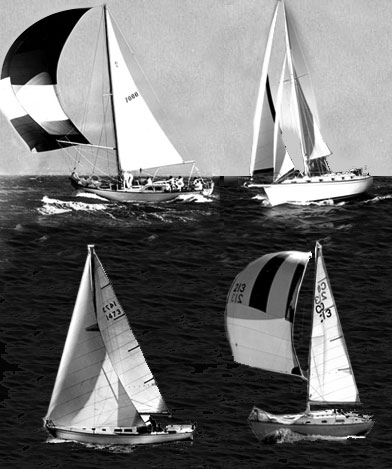
Sailors are certainly passionate about their boats, and if you doubt that bold statement, try posting an article dubbed “ 40 Best Sailboats ” and see what happens.
Barely had the list gone live, when one reader responded, “Where do I begin? So many glaring omissions!” Like scores of others, he listed a number of sailboats and brands that we were too stupid to think of, but unlike some, he did sign off on a somewhat upbeat note: “If it weren’t for the presence of the Bermuda 40 in Cruising World’s list, I wouldn’t even have bothered to vote.”
By vote, he means that he, like hundreds of other readers, took the time to click through to an accompanying page where we asked you to help us reshuffle our alphabetical listing of noteworthy production sailboats so that we could rank them instead by popularity. So we ask you to keep in mind that this list of the best sailboats was created by our readers.
The quest to building this list all began with such a simple question, one that’s probably been posed at one time or another in any bar where sailors meet to raise a glass or two: If you had to pick, what’re the best sailboats ever built?
In no time, a dozen or more from a variety of sailboat manufacturers were on the table and the debate was on. And so, having fun with it, we decided to put the same question to a handful of CW ‘s friends: writers and sailors and designers and builders whose opinions we value. Their favorites poured in and soon an inkling of a list began to take shape. To corral things a bit and avoid going all the way back to Joshua Slocum and his venerable Spray —Hell, to Noah and his infamous Ark —we decided to focus our concentration on production monohull sailboats, which literally opened up the sport to anyone who wanted to get out on the water. And since CW is on the verge or turning 40, we decided that would be a nice round number at which to draw the line and usher in our coming ruby anniversary.
If you enjoy scrolling through this list, which includes all types of sailboats, then perhaps you would also be interested in browsing our list of the Best Cruising Sailboats . Check it out and, of course, feel free to add your favorite boat, too. Here at Cruising World , we like nothing better than talking about boats, and it turns out, so do you.
– LEARN THE NAVIGATION RULES – Know the “Rules of the Road” that govern all boat traffic. Be courteous and never assume other boaters can see you. Safety Tip Provided by the U.S. Coast Guard
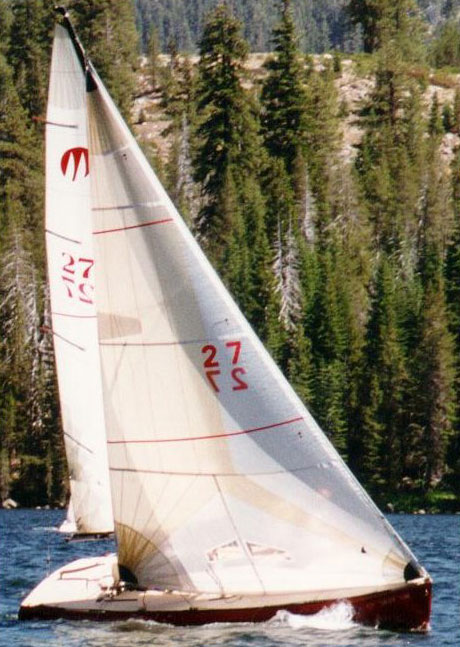
40. Moore 24
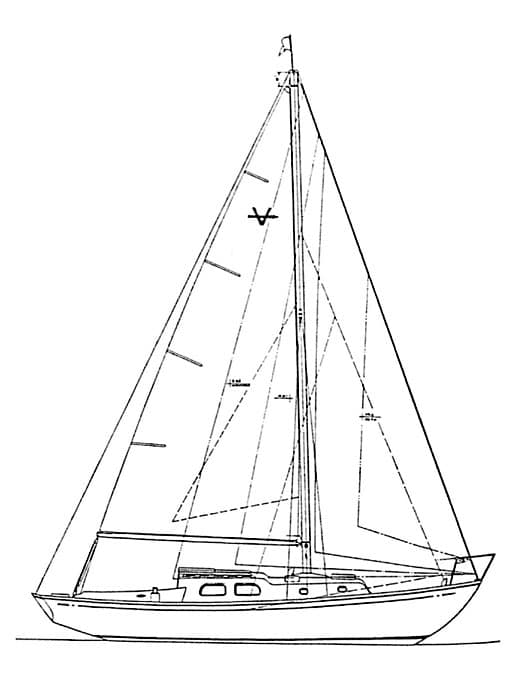
39. Pearson Vanguard
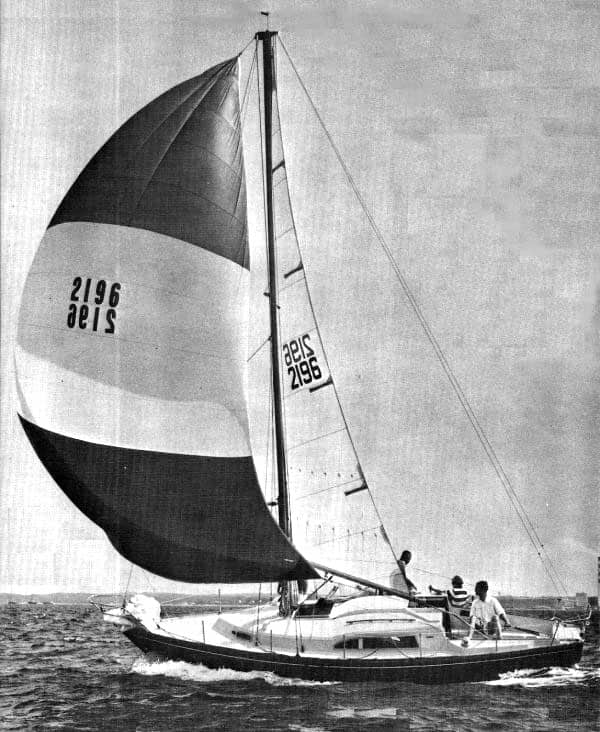
38. Dufour Arpege 30
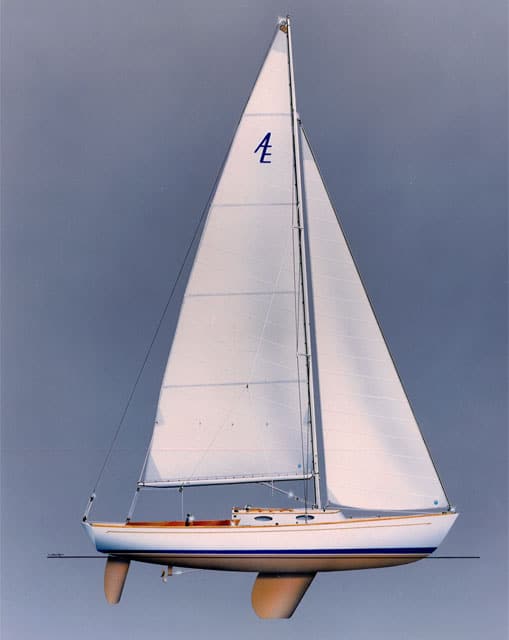
37. Alerion Express 28
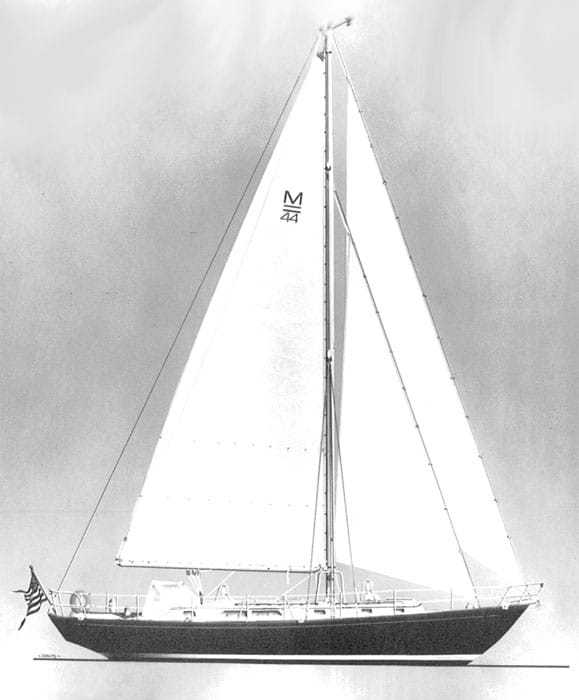
36. Mason 43/44
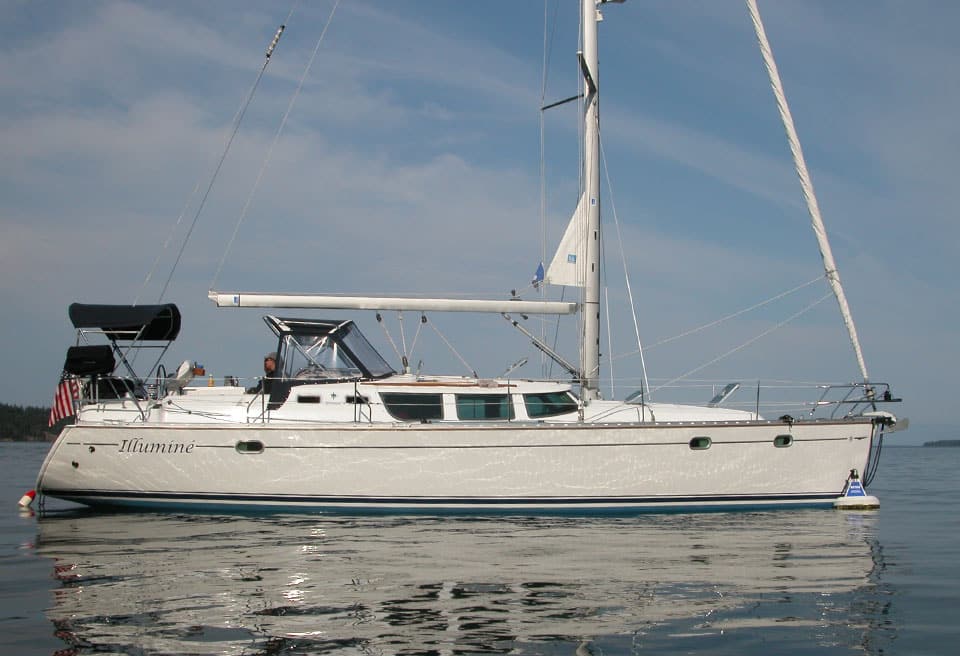
35. Jeanneau Sun Odyssey 43DS
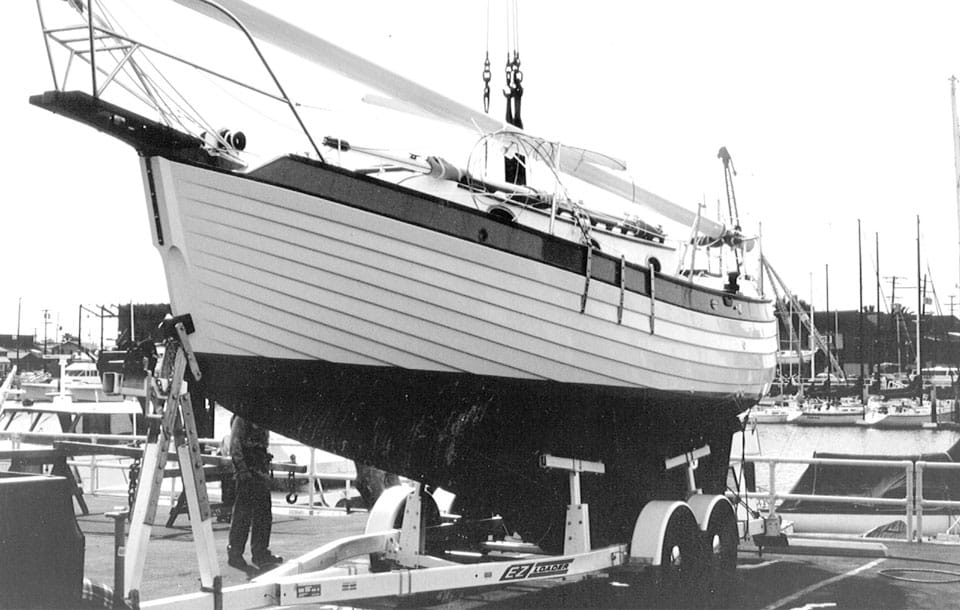
34. Nor’Sea 27
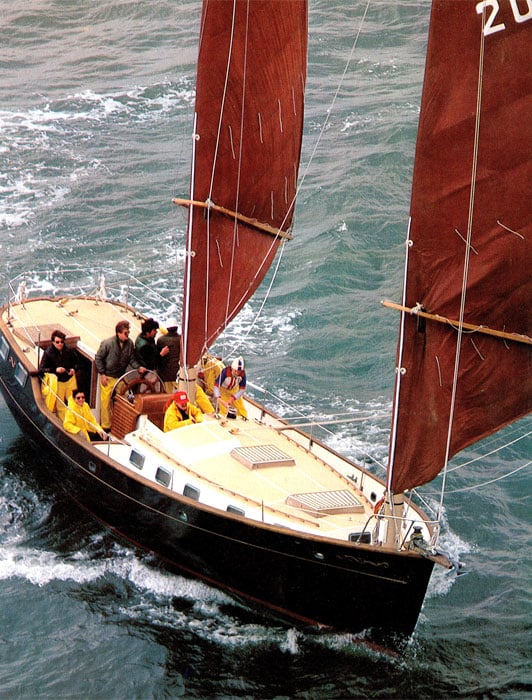
33. Freedom 40
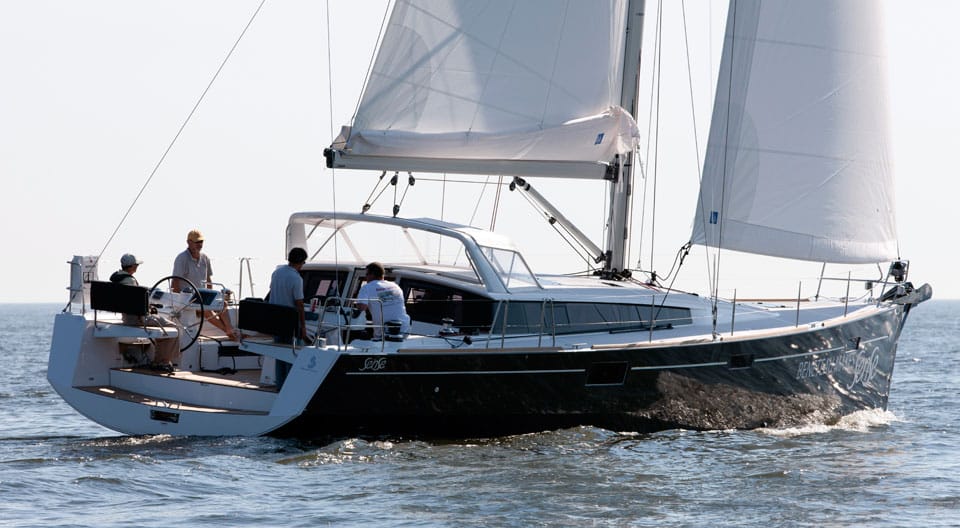
32. Beneteau Sense 50
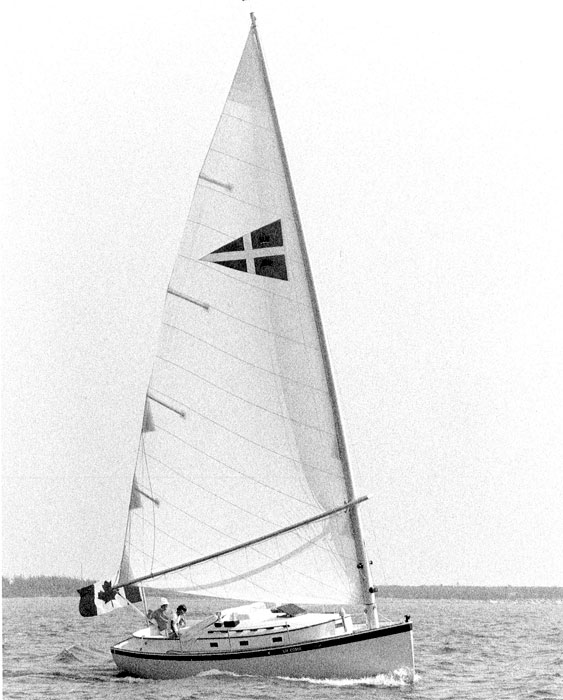
31. Nonsuch 30
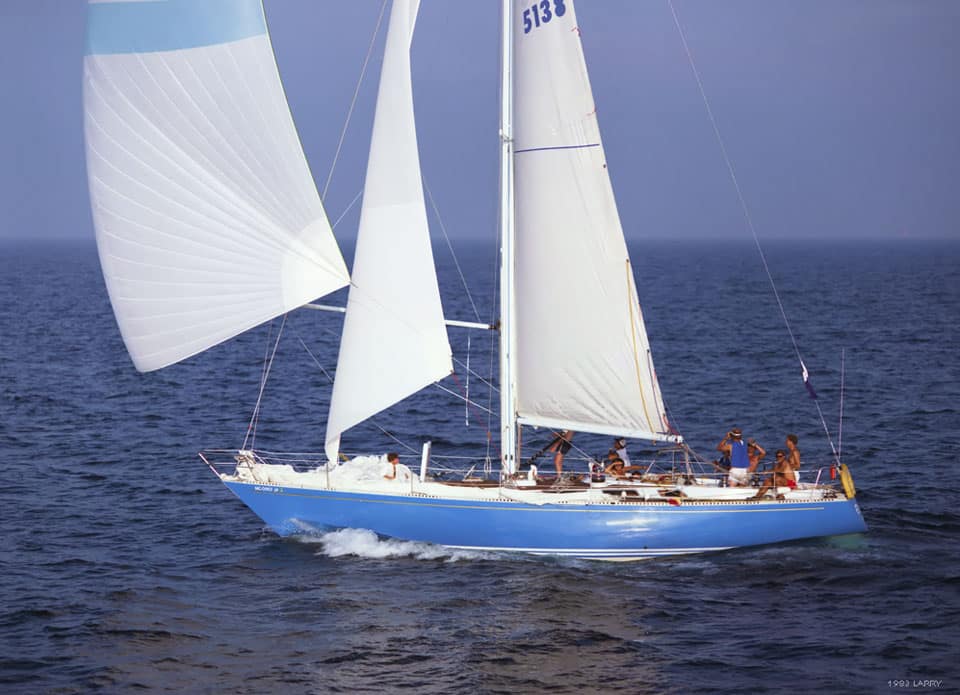
30. Swan 44
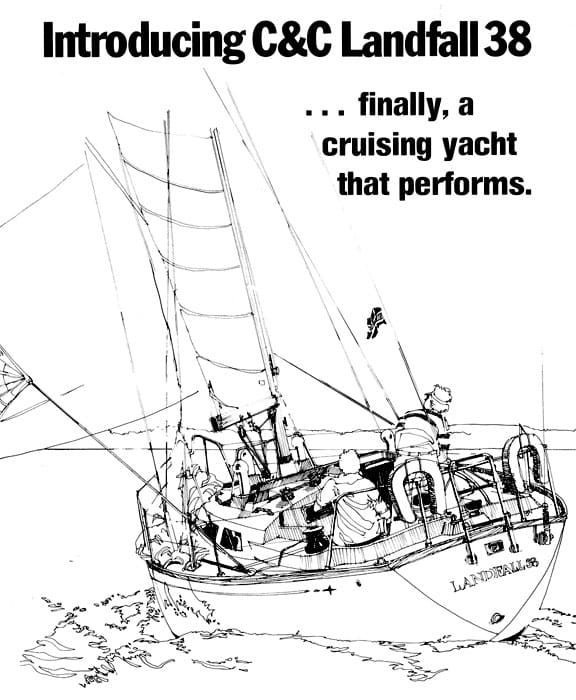
29. C&C Landfall 38
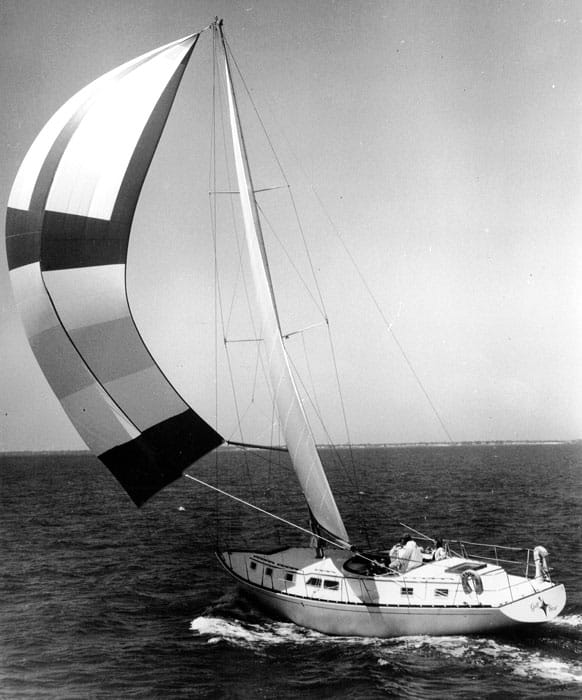
28. Gulfstar 50
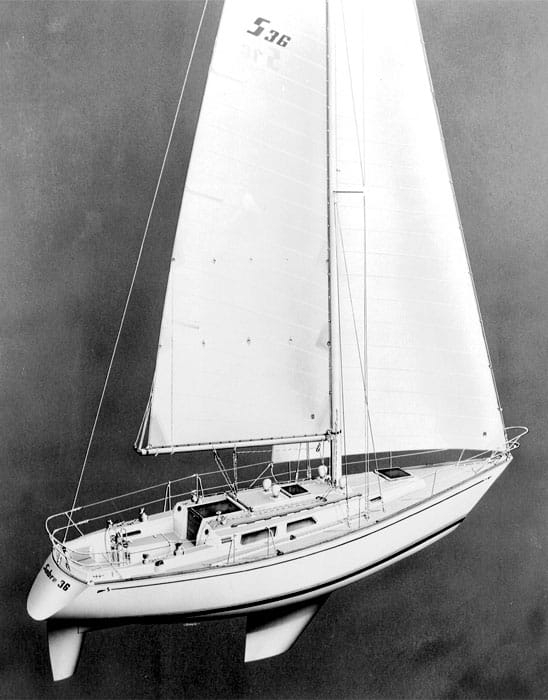
27. Sabre 36
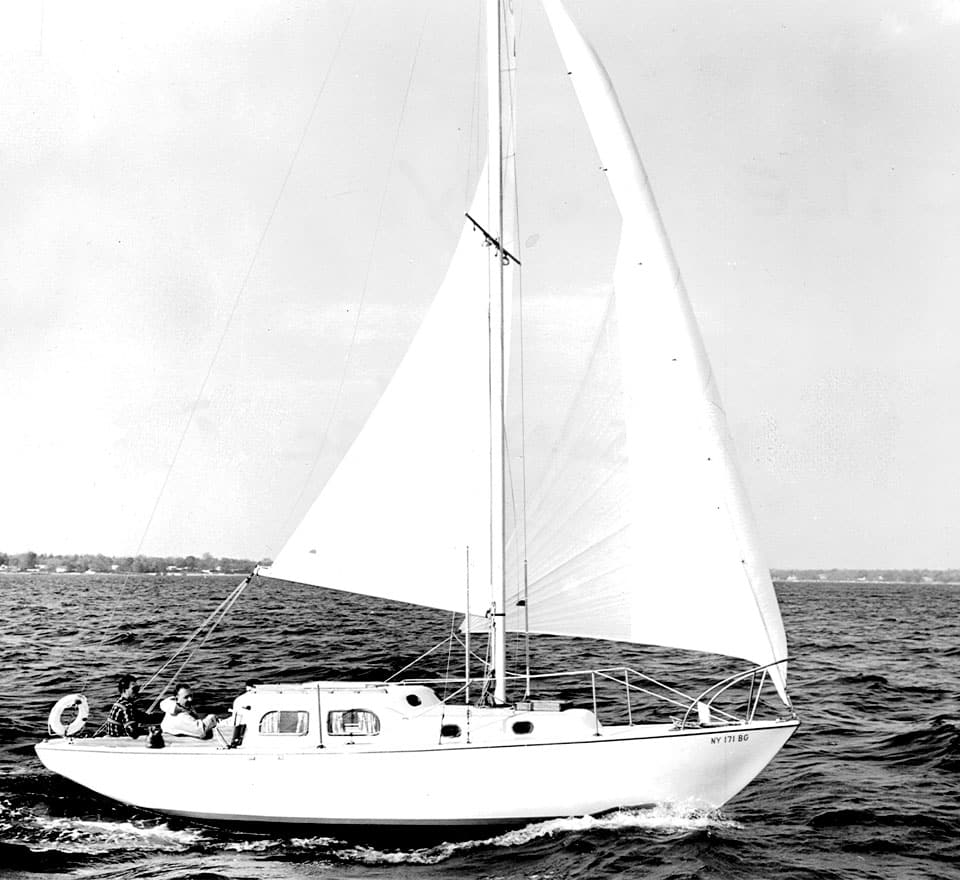
26. Pearson Triton
– CHECK THE FIT – Follow these guidelines to make sure your life jacket looks good, stays comfortable and works when you need it. Safety Tip Provided by the U.S. Coast Guard
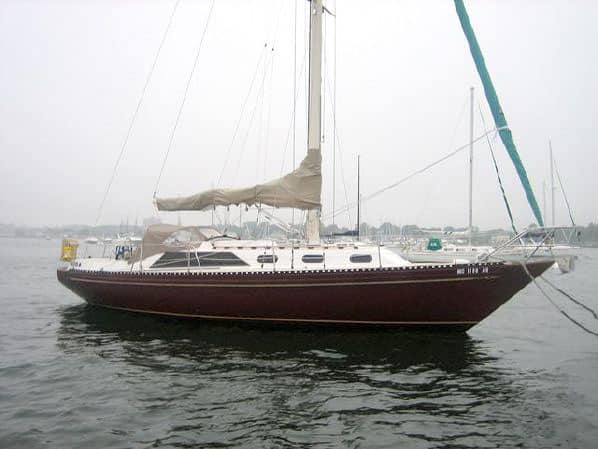
25. Islander 36
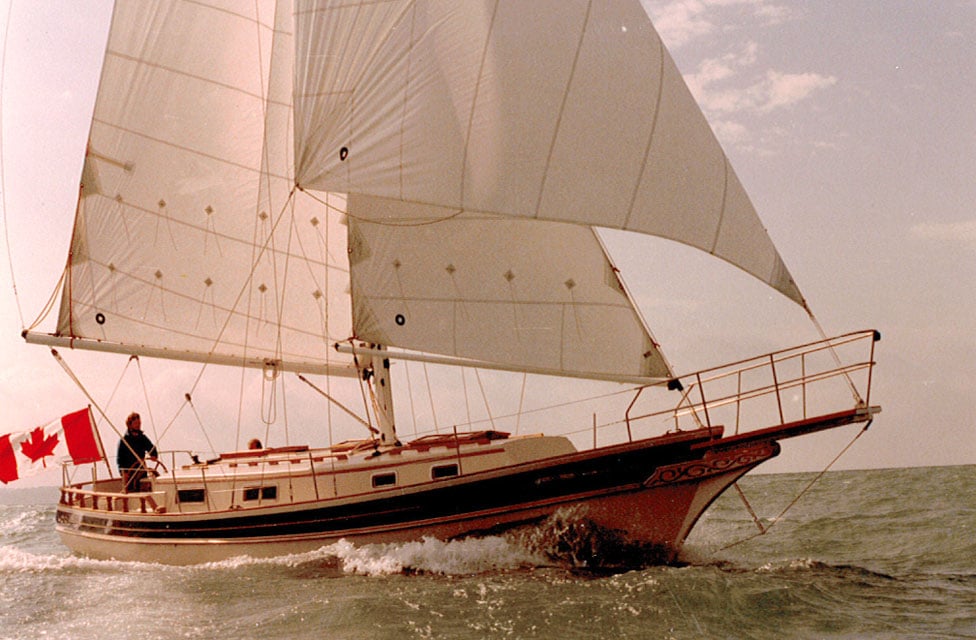
24. Gozzard 36
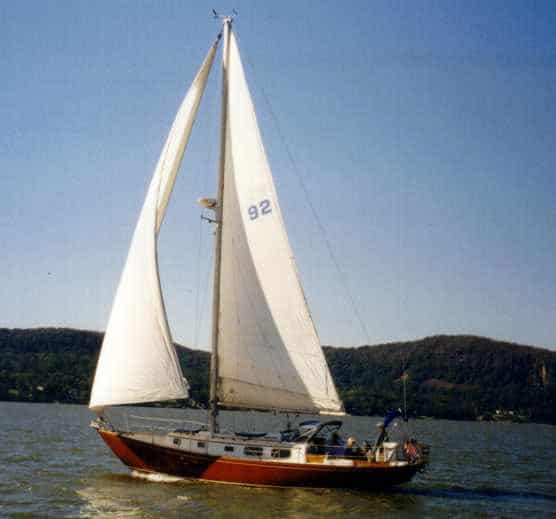
23. Bristol 40
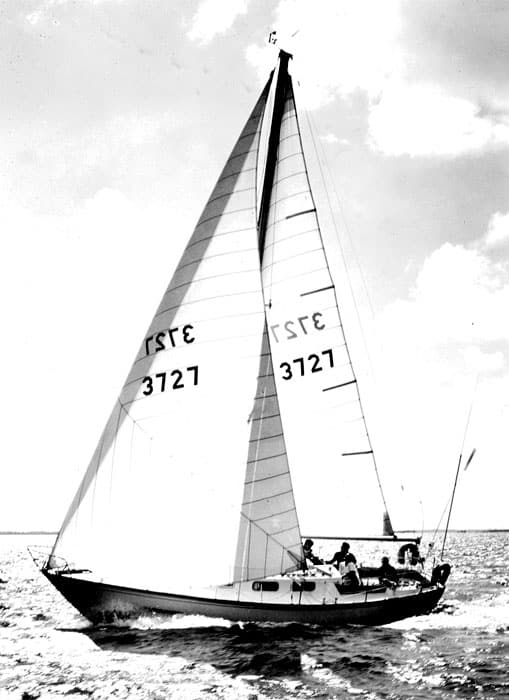
22. Tartan 34
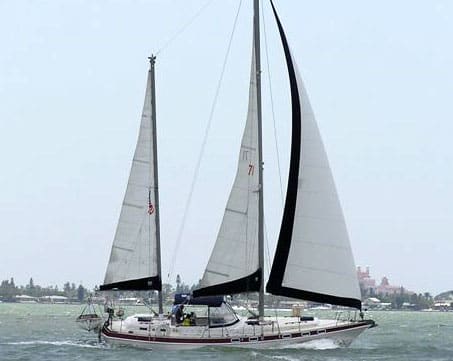
21. Morgan Out Island 41
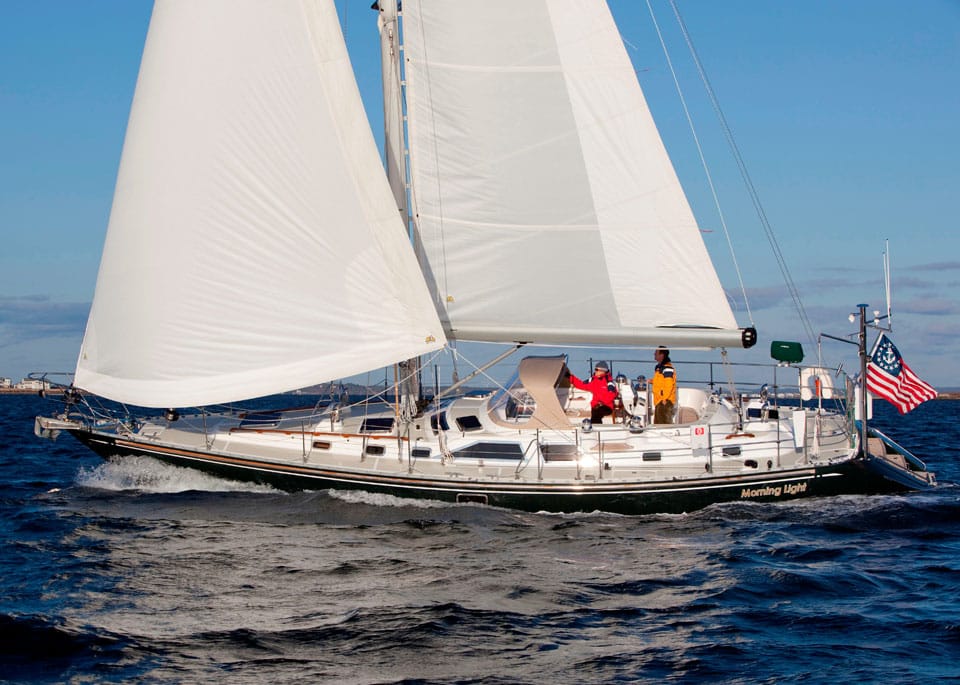
20. Hylas 49
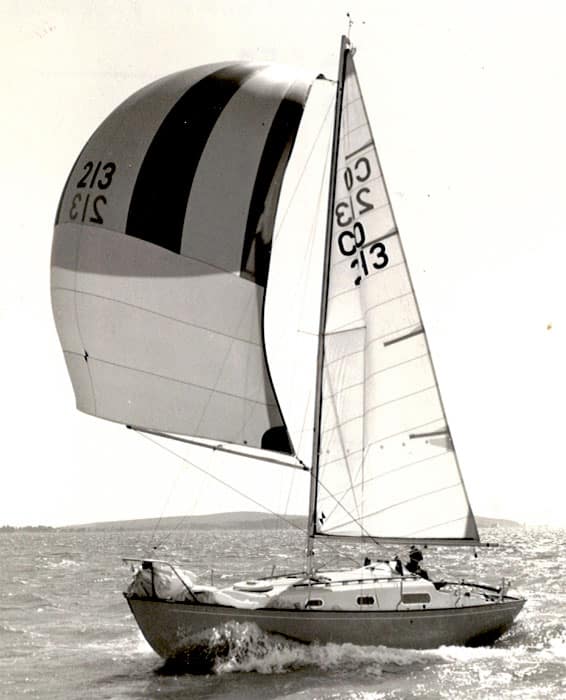
19. Contessa 26
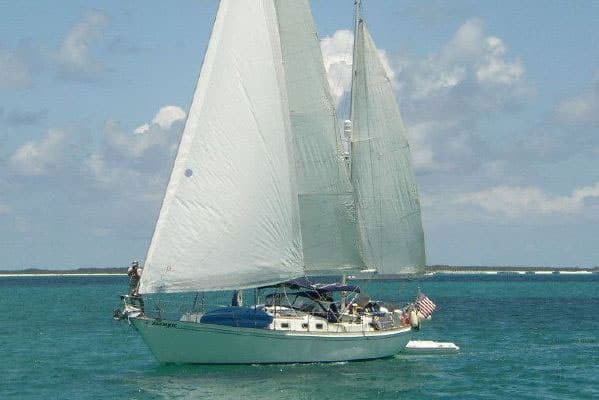
18. Whitby 42
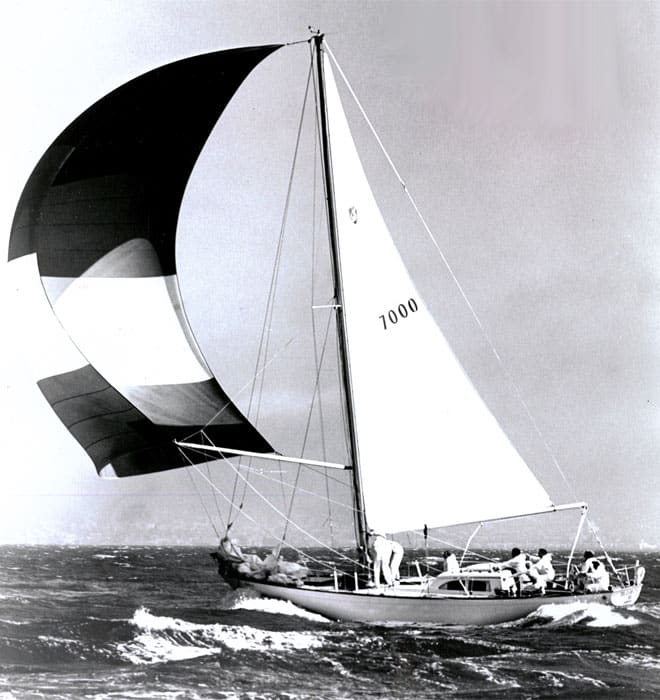
17. Columbia 50
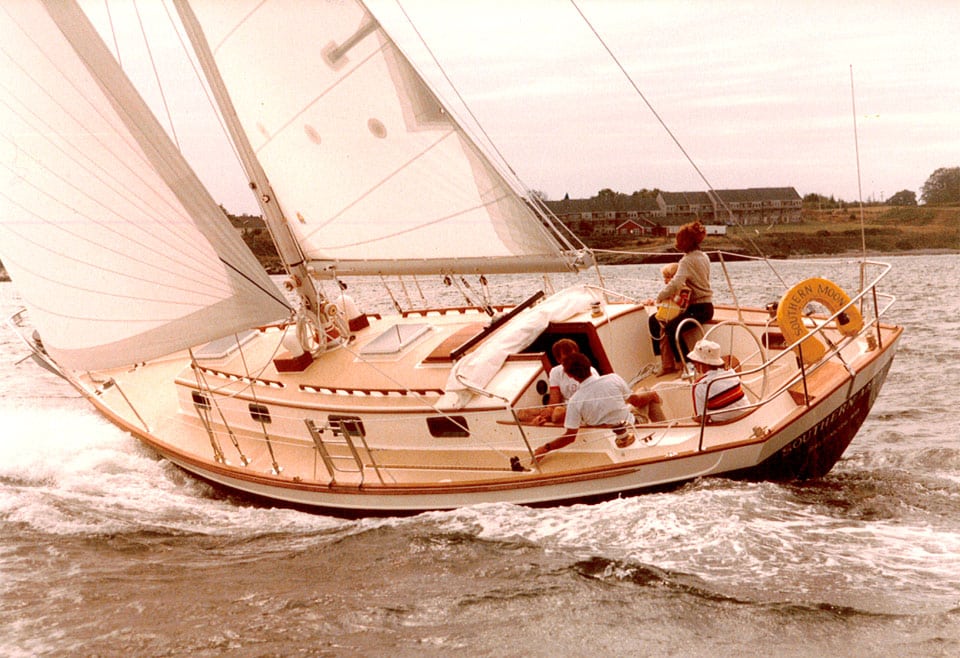
16. Morris 36
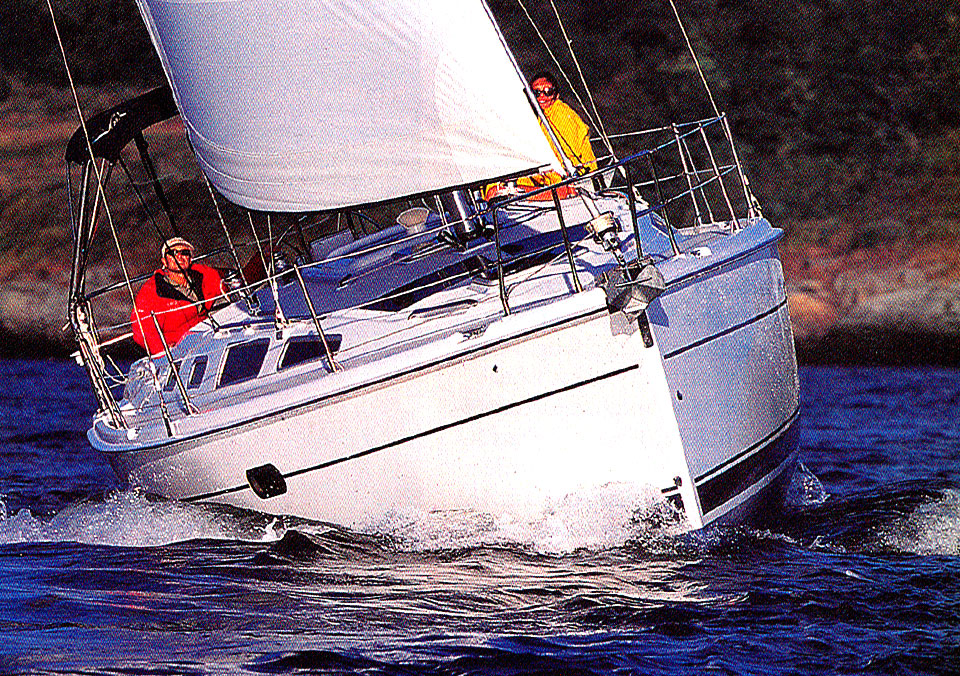
15. Hunter 356
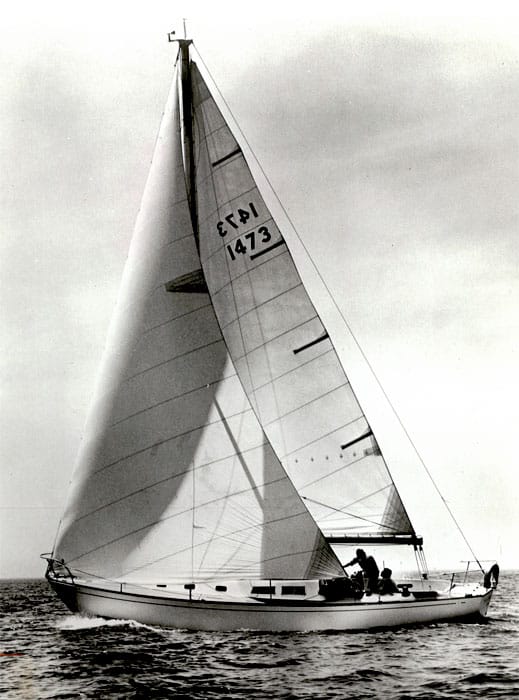
13. Beneteau 423
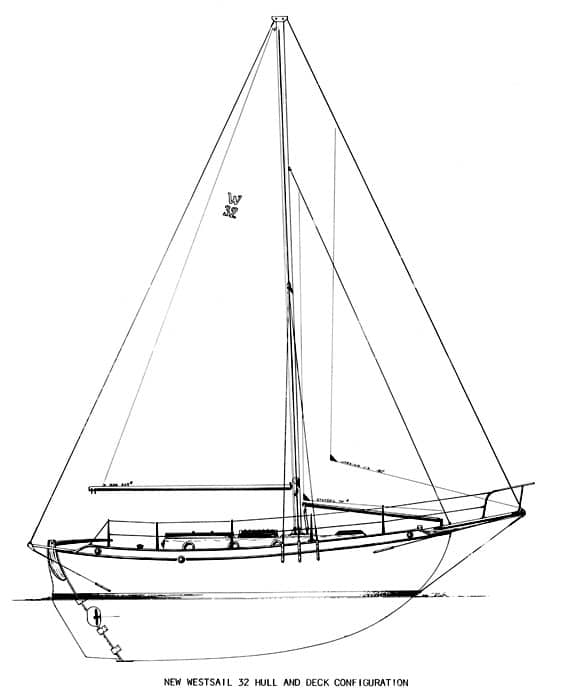

12. Westsail 32
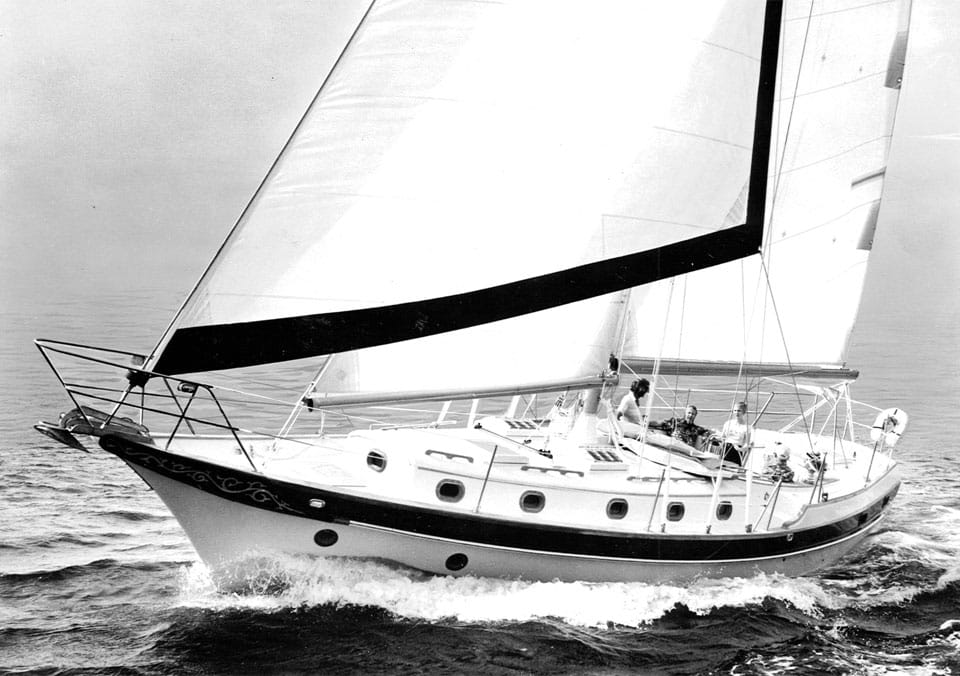
– CHECK THE WEATHER – The weather changes all the time. Always check the forecast and prepare for the worst case. Safety Tip Provided by the U.S. Coast Guard
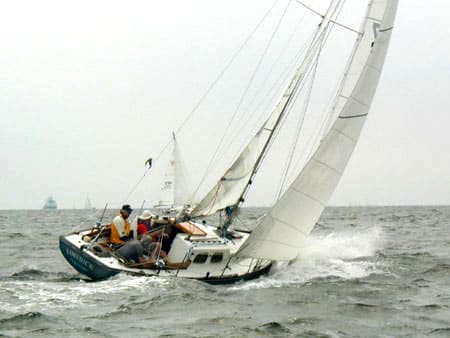
10. Alberg 30
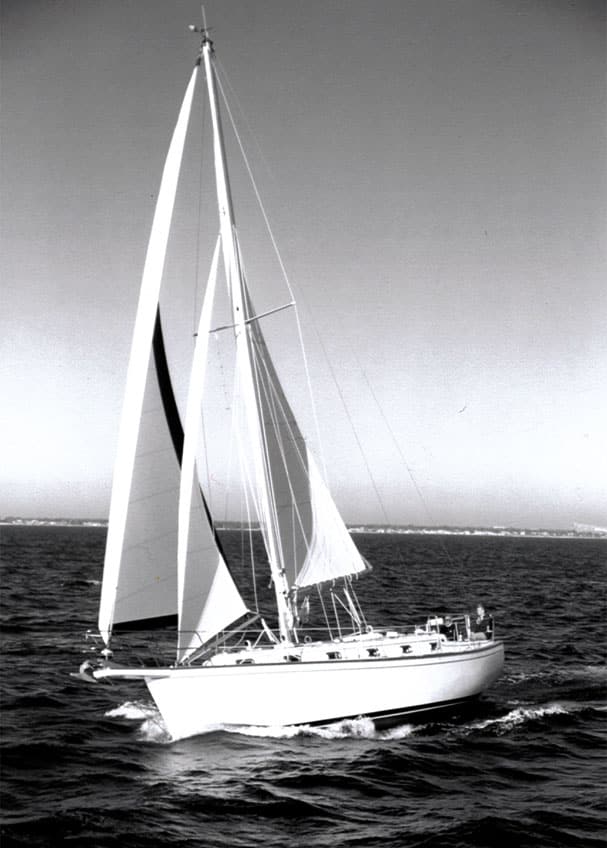
9. Island Packet 38
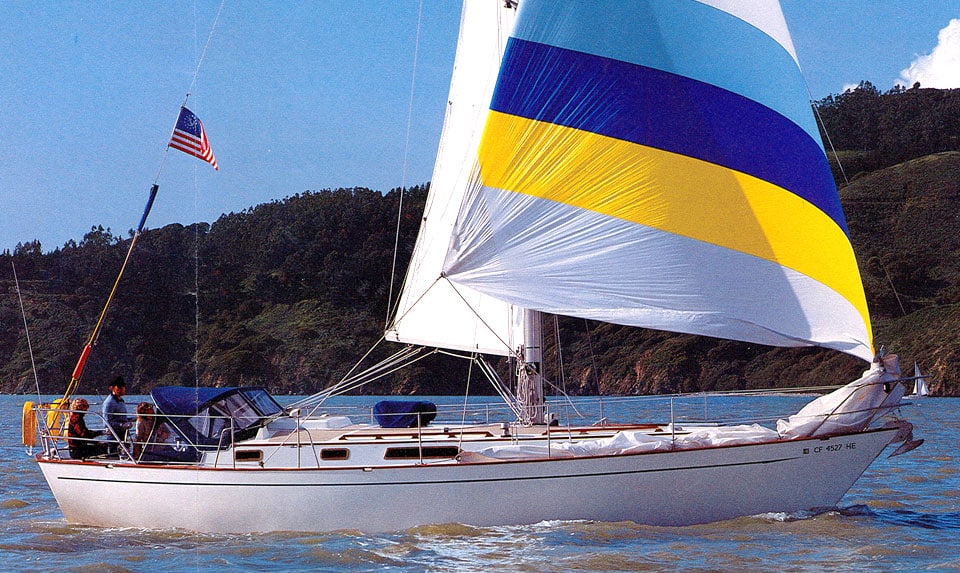
8. Passport 40
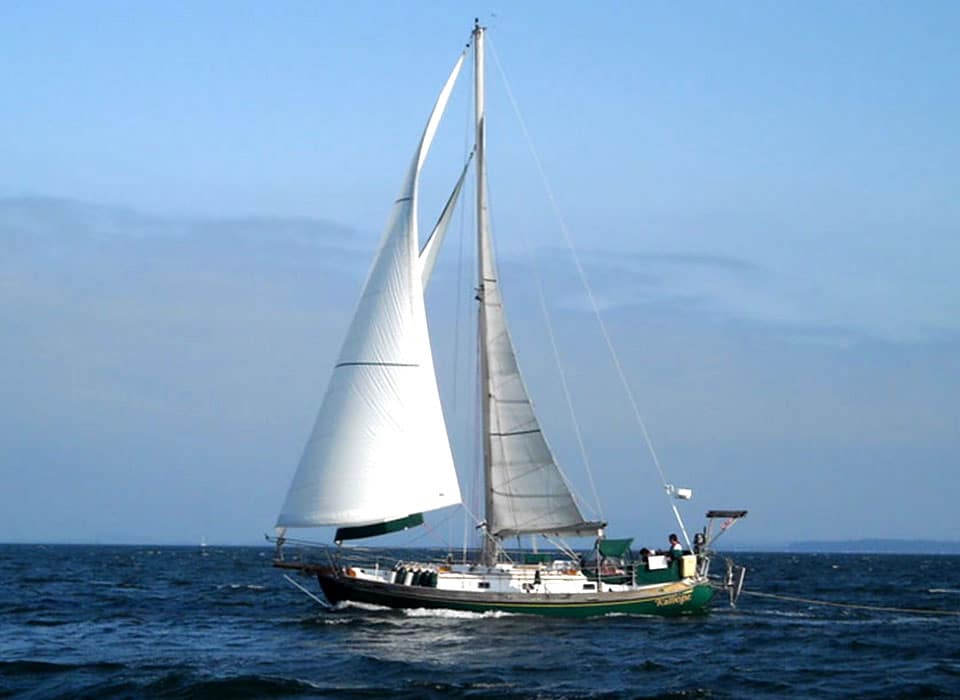
7. Tayana 37
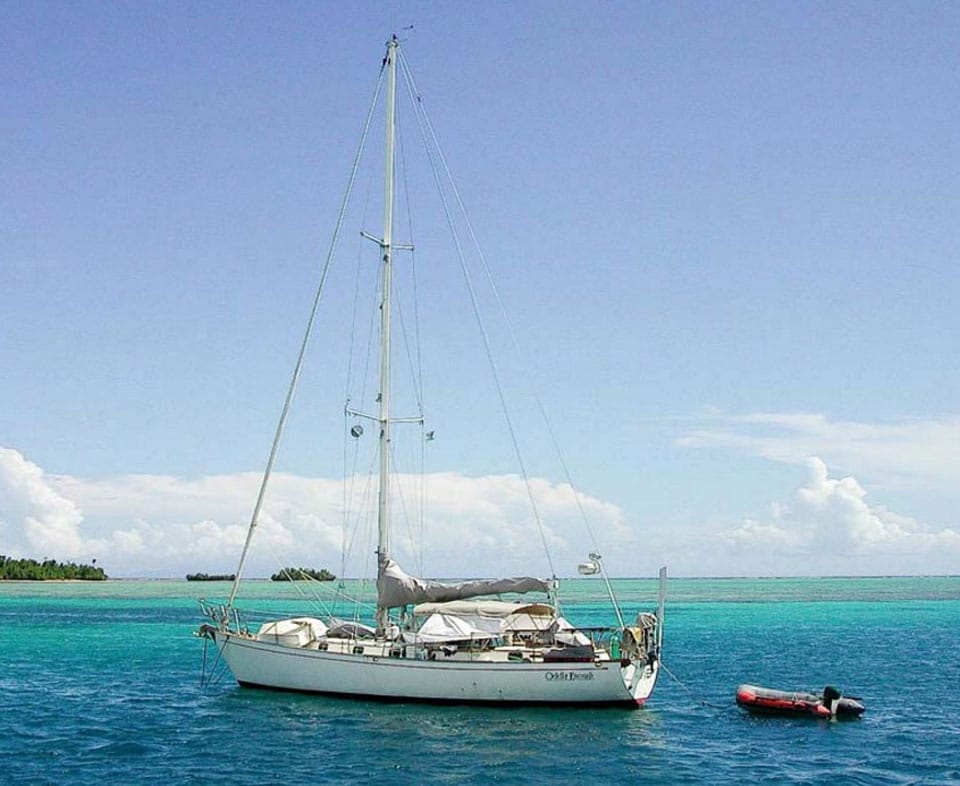
6. Peterson 44
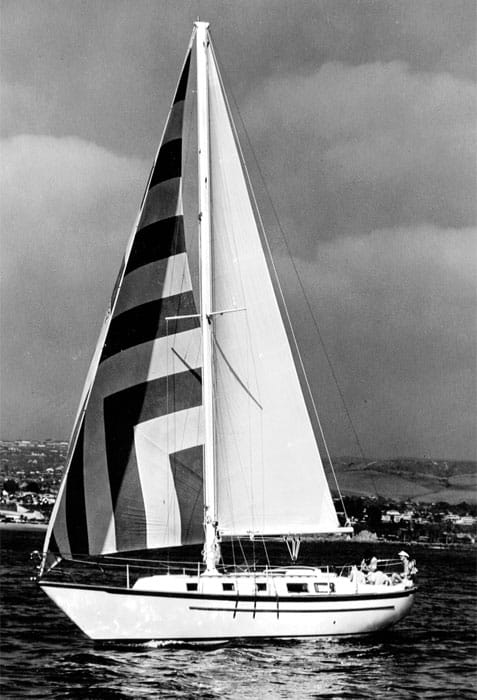
5. Pacific Seacraft 37
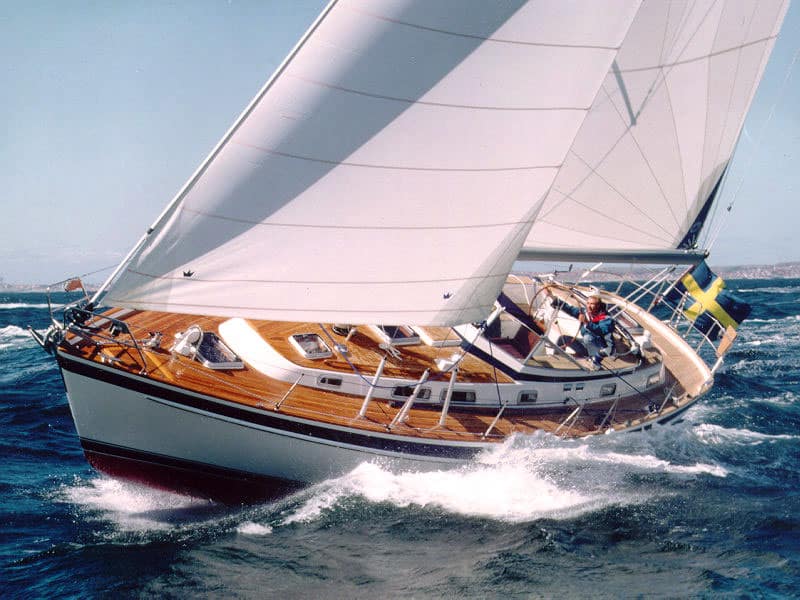
4. Hallberg-Rassy 42
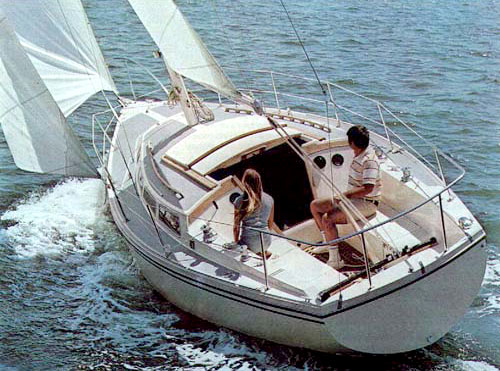
3. Catalina 30
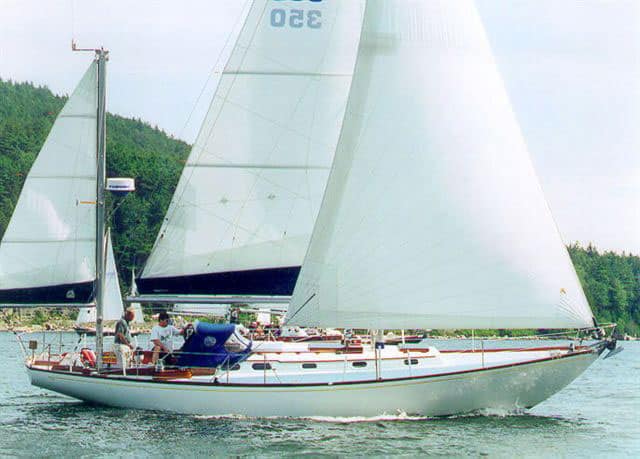
2. Hinckley Bermuda 40
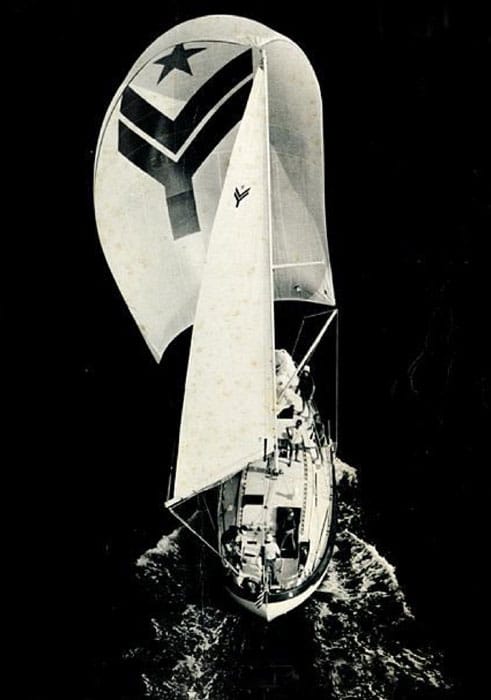
1. Valiant 40
- More: monohull , Sailboats
- More Sailboats

Pre-Owned: 1988 Hylas 47

Catalina Introduces the 6 Series

Sailboat Preview: Elan GT6 Explorer

For Sale: 1984 Camper & Nicholsons 58
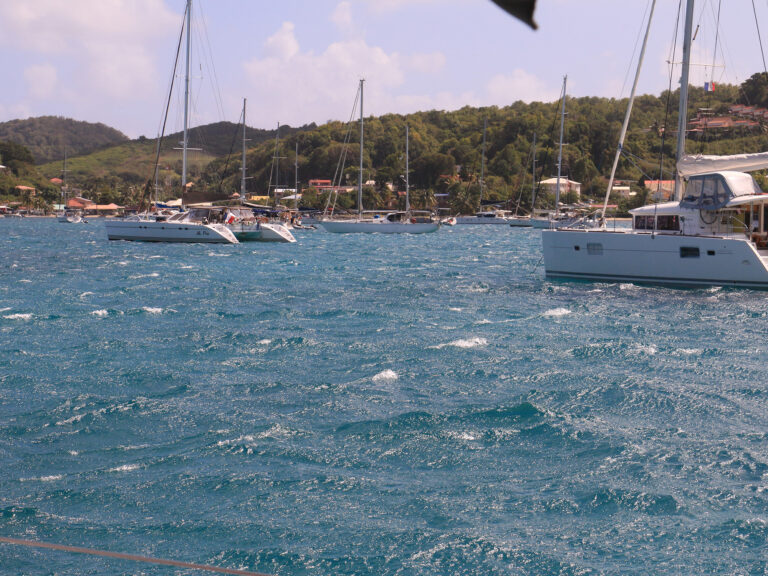
Understanding Wind in the West Indies
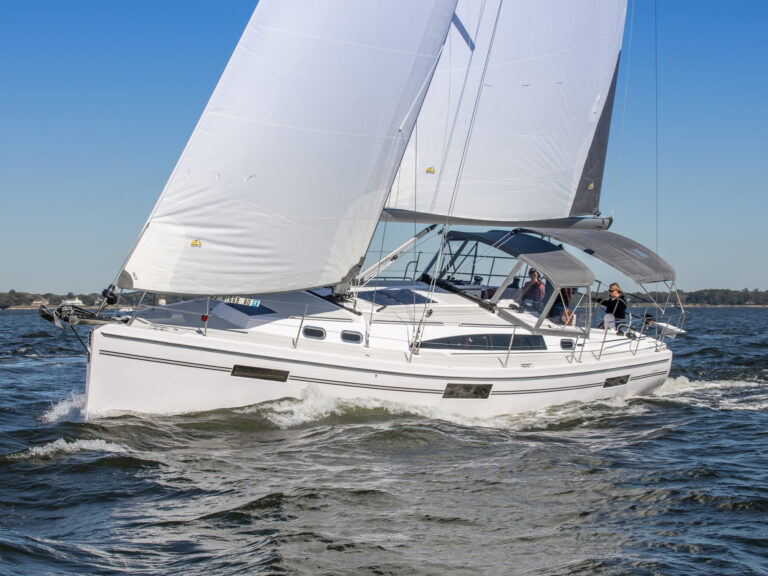
At Your Service

Galápagos: A Paradise Worth the Paperwork
- Digital Edition
- Customer Service
- Privacy Policy
- Terms of Use
- Email Newsletters
- Cruising World
- Sailing World
- Salt Water Sportsman
- Sport Fishing
- Wakeboarding
- Oceanis 30.1
- Oceanis 34.1
- Oceanis 37.1
- Oceanis 40.1
- Oceanis 46.1
- Oceanis 51.1
- Oceanis Yacht 54
- Oceanis Yacht 60
- FIGARO BENETEAU 3
- Heritage sailing yacht
- Flyer 6 SUNdeck
- FLYER 6 SPACEdeck
- Flyer 7 SUNdeck
- Flyer 7 SPACEdeck
- Flyer 8 SUNdeck
- Flyer 8 SPACEdeck
- Flyer 9 SUNdeck
- Flyer 9 SPACEdeck
- Antares 7 Fishing
- Antares 8 Fishing
- ANTARES 11 FLY
- Gran Turismo 32
- Gran Turismo 36
- Gran Turismo 41
- Gran Turismo 45
- Swift Trawler 35
- Swift trawler 41 Sedan
- Swift trawler 41 Fly
- Swift Trawler 48
- Swift Trawler 54
- Grand Trawler 62
- Heritage motorboats
- A REMARKABLE ANNIVERSARY
- Architects and Designers
- Become a BENETEAU boat owner
- Tests and Awards

Introducing the Exciting New Planing Cruiser, the First 30
This innovative model promises to give all sailors the thrill of planing while delivering top-level performance.
Updating a Legacy
The First 30 follows in the footsteps of the popular model launched in 1977 , which shaped the history of BENETEAU. The brand worked with Seascape for this new version, assembling a team of world-class designers and engineers: Samuel Manuard for the naval architecture and Lorenzo Argento for the design. This bold new project demonstrates BENETEAU’s commitment to innovation and is particularly meaningful as the brand celebrates its 140th anniversary .

Performance and Comfort: Safe, Smooth Sailing
The First 30 is 10.33 metres long and has a displacement of 3,150 kg, meaning that even small crews can enjoy quick easy planing .
Planing is that magical moment when, at full speed, your yacht’s hull lifts and is in limited contact with the water, minimising friction and creating a smooth, gliding sensation. You feel the thrill of the boat accelerating, and every manoeuvre is smoother and more responsive. It is this adrenalin rush that promises unique unforgettable moments at sea! A clear cockpit and simple rigging make navigation fun and intuitive, even at high speeds. Additional options for racers optimise performance. Designed for effortless sailing, the First 30 is perfect for cruising and for racing. By choosing the layout – cruising or racing – it can be perfectly matched to the needs of each skipper. The cruising version features large winches and ergonomic controls to simplify handling, while the racing version includes a mainsail traveller for more accurate trimming.
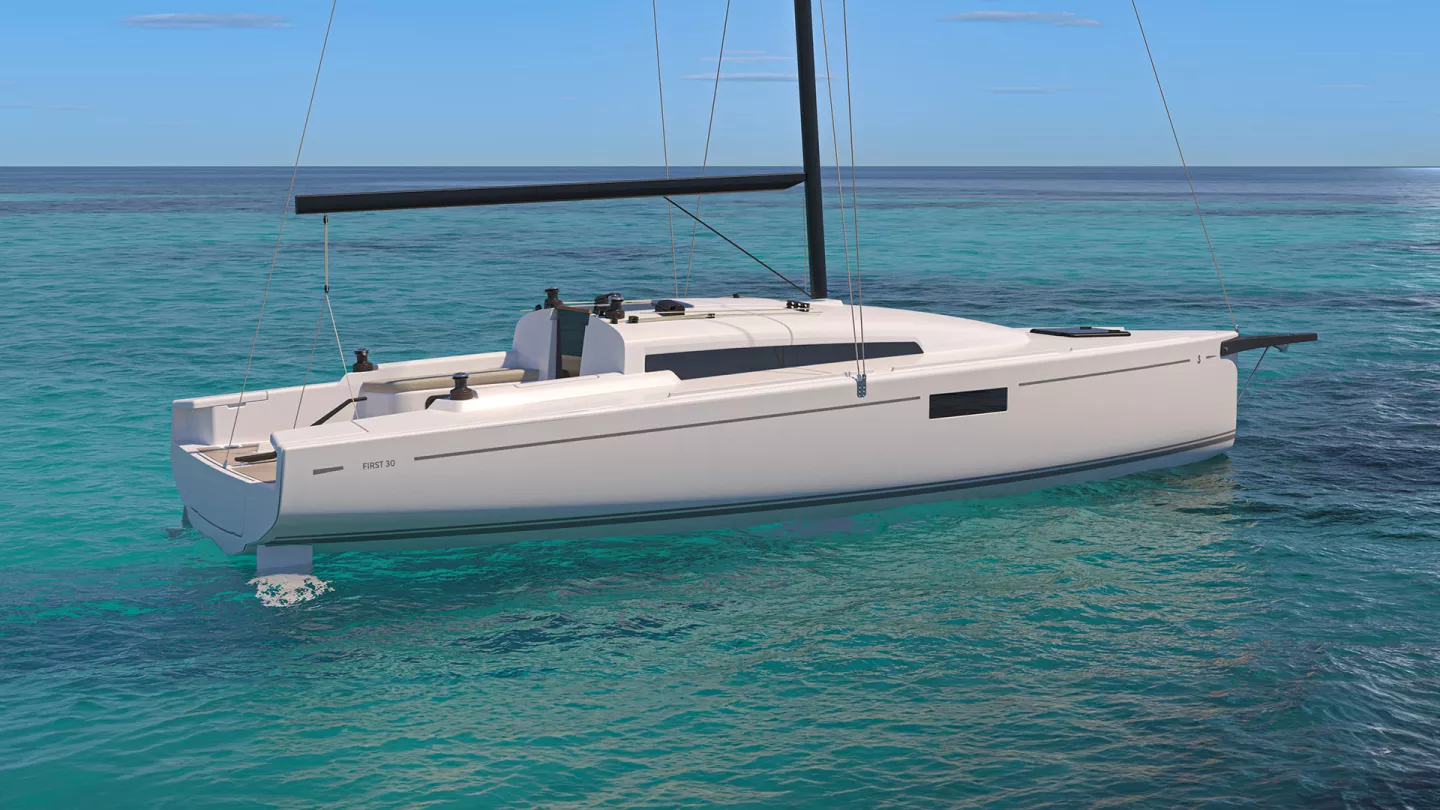
A Practical, User-Friendly Interior for Worry-Free Cruising
Below deck, the boat has a capacity of 4 people divided between two cabins. The First 30 is the perfect boat for cruising with family or friends. Cruising is truly enjoyable, with a comfortable saloon, fully-fitted galley and smart storage spaces.
With the Premium Pack option, you have additional features and the interior is more stylish with top-quality upholstery, extra lounge backrests, a chopping board, choice of colours and materials, and mood lighting.

With the new First 30 , BENETEAU once again proves its ability to push back the boundaries of innovation while remaining true to its heritage. Designed to become a true benchmark, the First 30 will make its world premiere at the Düsseldorf 2025 boat show.
Sign up now for our newsletter, so you do not miss out on the upcoming launch.
Published on 10.09.2024
- Sailing yacht
Select your area and your language
- American english
- Chinese, Simplified

- Forum Listing
- Marketplace
- Advanced Search
- About The Boat
- Boat Builders Row
- Pacific Seacraft
- SailNet is a forum community dedicated to Sailing enthusiasts. Come join the discussion about sailing, modifications, classifieds, troubleshooting, repairs, reviews, maintenance, and more!
long distance cruising in a PS 34?
- Add to quote
Any Pacific Seacraft 34 owners out there complete a major passage; i.e., crossing the Atlantic or Pacific Oceans? I know the boat is capable of doing so safely, but from what I have read it seems like most major passages are made on boats > 40 ft.
Joshua Slocum's Spray was 36-foot-9-inches long. About 14 sub-40 footers are presently racing around the world single-handed, nonstop. Check out the Mini Transat 6.50 if you want to see even smaller boats crossing the Atlantic. You don't need a 40 plus footer to cross oceans any more than you need a huge SUV to commute to work. In both cases, it is the person making the decisions that will make or break any trip. The size of the boat, however, directly affects the comfort of those aboard. Some of us prefer the home-like comforts of a larger boat and others are perfectly happy to camp out, living in a cramped, tiny space.
capta said: Joshua Slocum's Spray was 36-foot-9-inches long. Click to expand...
Try Googling "Voyage of the Swan" and read about Dave and Rhonda Mancini's voyages in their PSC 34. Dave provided an amazing amount of information about his PSC 34 and his cruising. You can also search this site for his entries.
I will definitely check that out - thanks!
:cut_out_animated_em forgive my ignorance,, but what do they do when storms come round try to out sail them? I'd think that would be a helluva bumpy ride in a small boat...
The theory is the bigger a boat the better it can handle heavy weather. Which would be more comfortable in a storm, a 45 footer racer/cruiser or a full keeled double ender like the PSC34?
Throw a Jordan series drogue off the stern, button up, take a sturgeron and go to sleep on the saloon sole just like you would on a bigger boat. Unless you’re on a Rapido 60 this business of outrunning storms is fantasy. You can preposition to miss a cyclonic depression with sufficient forewarning on occasion but think any boat going to sea should be able to handle a gale with storm sails and a storm with drogue or sea anchor
When we were out doing French Polynesia in the '70s, most boats were under 40', many well under. One French Couple had sailed from home in a converted Life Boat that wasn't much more than 20' if that. Grant, who probably is on the list, cruised with his wife on a 26' boat, we were on a 32', many others in boats in the mid 30's. The single humongous boat was a 44' that had the novelty of novelties, a washer dryer combo. Their gear was good for a lot of conversation among us cruisers on why you'd want, let alone install, a W/D on a boat. The idea of cruising on a boat bigger than 40' was largely a foreign concept. Of course most of us were in our late 20's, 30's and sailed what we could afford. Since GPS has ruined cruising, anyone with enough money to buy a condo can buy a floating one and point it somewhere. One upmanship seems to have taken over with half century catamarans that have more heads than crew aren't at all unusual. It's not that you need all that boat but that they can afford it. A boat with the reputation of the PSC should be stout enough even for sailing the Capes. Wouldn't hesitate a moment in taking one that was reasonably prepared almost anywhere.
A Pacific Seacraft 34 is a fine ocean going boat. Some people prefer a larger boat, some a smaller. Some prefer the motion of a traditional vessel, some like the more modern designs. I believe that there is no such thing as comfortable ride in a small boat in a storm. Like everything else, it's a trade-off. What is of more concern is the basic seaworthiness, the condition of the boat, and the proficiency of the crew. Seaworthyness has been debated at length on this and other forums. Different issues come to play, but the basic idea is that many boats are seaworthy, but some are obviously designed for non ocean use. That dosen't take into account, which ocean. Are we talking trans Pacific, or Southern Ocean? Antarctica or the Carribean. All of that matters. Leaving that debate for a while, look at the condition of the boat. When was the standing rigging replaced? How are the ... well the list goes on, as you can fill in for yourself. One area specific to the PS 34 is the condition of the chainplates. On every boat preparing for ocean use, the skipper is responsible for a huge amount of inspection and preparation. The longer the voyage, the more detailed the preparation. The crew is crucial. People point to Sloucum as an inspiration. I read a recent biography, sorry, I've forgotten the author, that recounted the depth of experience that he had on sailing vessels. How you sail the boat, how you react to situations (and emergencies) and how you know what needs to be done - and how to do it- make a huge difference in the safety and enjoyment of your passages. A well found PS 34, with a good crew. Hell yes, it would make a fine passage maker. So would a lot of other boats. There is one thing that I've neglected to discuss: Fate. Fate, luck, God's will ... whatever you call it. My friend calls it the Goddess of Chance. Sometimes things just work out. Sometimes they don't. Since a well found boat with a good crew are the best we can do, we pay our money and take our chances. Luck favors the prepaired mind is an old saying, true in life, and true in sailing.
75 gallons of water and 38 gallons of fuel is not small. Smaller boat, smaller diesel, lower fuel fuel consumption. The engine stated in Sailboat Data is 38hp which is way overpowered to my thinking. Have a 27hp Yanmar in my same size boat and it's more than adequate. Hopefully lower rpm will equate to lower fuel consumption even with too big engine. We had identical water capacity in two tanks. Caught water from the awning and never had to switch to 2nd between rainfalls filling the tanks back up in French Polynesia. Yes you can be profligate with water but disconnecting the pressure water pump and only using foot pumps is an instant no pain conservation technique. If you can't get by on the fuel and water capacity of a PSC 34 you really should consider a floating condo permanently attached to a dock with water and electric.
To address the original poster, Lisken (PSC34) has completed a transatlantic - last year I believe. She is now somewhere in the Sweden/Norway area. Sailed from Newfoundland to Ireland if I remember correctly. Hope the following link works: https://sailingthelisken.wordpress.com/
I will check it out, thanks!
Checking out "Voyages of Swan" is a great idea and a good resource. Reading through it years ago was instrumental in my decision to buy the PSC 34.
kbbarton: They accidentally gybed in strong wind. Here is the excerpt. "We are slower than yesterday. Running fast with main up didn’t work so well. Lesson Learned…Don’t run down wind with too much main sail! Especially if there are big waves causing yawing. You might jibe on a yaw causing the boom to crash across….Dumb Dumb Dumb but sometimes you have to learn the hard way. What happened? The boom broke in half just behind the main sheet pulleys!!!! On this boat the traveler is in front of the companionway hatch. So half the length of the boom is Aft of the pulleys. The clew of the main sail is pulled from the end of the boom even with one or two reefs. I had no idea that I could snap the boom in half. It was blowing 30 knots with 2 reefs when it happened. Anyway that’s why we have no main sail up and are going a little slower."
- ?
- 176.4K members
Top Contributors this Month
- New Sailboats
- Sailboats 21-30ft
- Sailboats 31-35ft
- Sailboats 36-40ft
- Sailboats Over 40ft
- Sailboats Under 21feet
- used_sailboats
- Apps and Computer Programs
- Communications
- Fishfinders
- Handheld Electronics
- Plotters MFDS Rradar
- Wind, Speed & Depth Instruments
- Anchoring Mooring
- Running Rigging
- Sails Canvas
- Standing Rigging
- Diesel Engines
- Off Grid Energy
- Cleaning Waxing
- DIY Projects
- Repair, Tools & Materials
- Spare Parts
- Tools & Gadgets
- Cabin Comfort
- Ventilation
- Footwear Apparel
- Foul Weather Gear
- Mailport & PS Advisor
- Inside Practical Sailor Blog
- Activate My Web Access
- Reset Password
- Customer Service

- Free Newsletter

Blue Jacket 40 Used Boat Review

Catalina 270 vs. The Beneteau First 265 Used Boat Match-Up

Ericson 41 Used Boat Review

Mason 33 Used Boat Review

How to Create a Bullet-Proof VHF/SSB Backup

Tips From A First “Sail” on the ICW

Tillerpilot Tips and Safety Cautions

Best Crimpers and Strippers for Fixing Marine Electrical Connectors

Polyester vs. Nylon Rode

Getting the Most Out of Older Sails

How (Not) to Tie Your Boat to a Dock

Stopping Mainsheet Twist

Fuel Lift Pump: Easy DIY Diesel Fuel System Diagnostic and Repair

Ensuring Safe Shorepower

Sinking? Check Your Stuffing Box

What Do You Do With Old Fiberglass Boats?

Boat Repairs for the Technically Illiterate

Boat Maintenance for the Technically Illiterate

Whats the Best Way to Restore Clear Plastic Windows?

Stopping Holding-tank Odors

Giving Bugs the Big Goodbye

Galley Gadgets for the Cruising Sailor

The Rain Catcher’s Guide

Sailing Gear for Kids

What’s the Best Sunscreen?

UV Clothing: Is It Worth the Hype?

Preparing Yourself for Solo Sailing

R. Tucker Thompson Tall Ship Youth Voyage

On Watch: This 60-Year-Old Hinckley Pilot 35 is Also a Working…

On Watch: America’s Cup

On Watch: All Eyes on Europe Sail Racing

Dear Readers
- Sailboat Reviews
This speedster is as specialized as it gets; mind-blowing performance, but almost no living space.
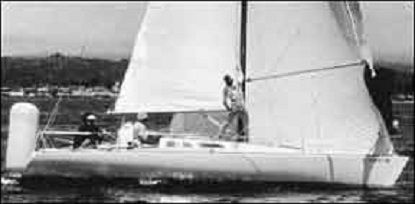
The Olson 30 is of a breed of sailboats born in Santa Cruz, California called the ULDB , an acronym for ultra light displacement boat. ULDBs are big dinghies—long on the waterline, short on the interior, narrow on the beam, and very light on both the displacement and the price tag. ULDBs attract a different kind of sailor—the type for whom performance means everything.
For some yachting traditionalists, the arrival of ULDB has been a hard pill to swallow. Part of this is simple resentment of a ULDB’s ability to sail boat for-boat with a racer-cruiser up to 15′ longer (and a whole lot more expensive). Part of it is the realization that, to sail a ULDB might mean having to learn a whole new set of sailing skills. Part of it is a reaction to the near-manic enthusiasts of Santa Cruz, where nearly 100 ULDBs race for pure fun—without the help of race committees, protest committees, or handicaps (in Santa Cruz, IOR is a dirty word). And part of the traditionalists’ resentment is their gut feeling that ULDBs aren’t real yachts.
In 1970, Californian George Olson tried an experiment and created the first ULDB. He thought if he took a boat with the same displacement and sail area as a Cal 20, but made it longer and narrower, it might go faster. The boat he built was called Grendel and it did go faster than a Cal 20, much faster than anyone had expected. The plug for Grendel was later widened by Santa Cruz boatbuilder Ran Moors, and used to make the mold for the Moore 24, a now-popular ULDB one-design.
In the meantime, George Olson had joined up with another Santa Cruz builder by the name of Bill Lee, and together they designed and built the Santa Cruz 27. Olson also helped Lee build his 1977 Transpac winner Merlin, a 67′, 20,000 pound monster of a ULDB (she was subsequently legislated out of theTranspac race). Then Olson and several other of Lee’s employees started their own boatbuilding firm (in Santa Cruz, of course) called Pacific Boats. The first project for Pacific Boats was the Olson 30, which was put into production in 1978. Pacific Boats later became Olson/Ericson, and produced a 25 and a 40. The latest incarnation of the 30 is called the 911.
Construction
Some people wonder how ULDBs can be built so light, yet still be seaworthy offshore. The answer is three-fold: first, a light boat is subjected to lighter loads, when pounding through a heavy sea, than a boat of greater displacement. Second, there is a tremendous saving in weight with a stripped-out interior. Third, as a whole, ULDB builders have construction standards that are well above average for production sailboats. The ULDB builders say that their close proximity to each other in Santa Cruz combined with an open sharing of technology has enabled them to achieve these standards.
The Olson 30 is no exception. The hull and deck are fiberglass vacuum-bagged over a balsa core. The process of vacuum-bagging insures maximum saturation of the laminate and core with a minimum of resin, making the hull light and stiff. The builder claims that they have so refined the construction of the Olson 30 that each finished hull weighs within 10 pounds of the standard. The deck of the Olson does not have plywood inserts in place of the balsa where winches are mounted, instead relying on external backing plates for strength.
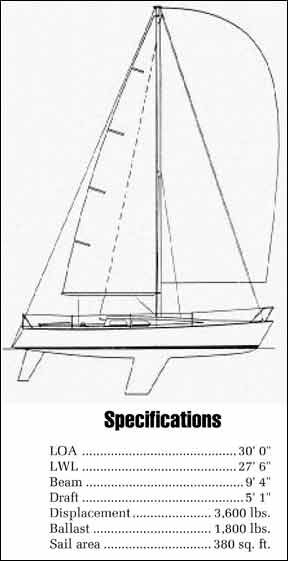
The hull-to-deck joint is an inward turned overlapping flange, glued with a rigid compound called Reid’s adhesive, and mechanically fastened with closely spaced bolts through a slotted aluminum toerail. This provides a strong, protected joint, seaworthy enough for sailing offshore. We would prefer a semi-rigid adhesive, however, because it is less likely to fracture and cause a leak in the event of a hard collision. The aluminum toerail provides a convenient location for outboard sheet leads, but is painful to those sitting on the rail.
The Olson 30’s 1,800 pound keel is deep (5.1′ draft) and less than 5″ thick. Narrow, bolted-on keels need extra athwartships support. The Olson 30 accomplishes this with nine 5/8″ bolts and one 1″ bolt (to which the lifting eye is attached). The lead keel is faired with auto body putty and then completely wrapped with fiberglass to seal the putty from the marine environment. Too many builders neglect sealing auto body putty-faired keels, and too many boat owners then find the putty peeling off at a later date. The Olson’s finished keel is painted, and, on the boats we have seen, remarkably fair.
The keel-stepped, single-spreader, tapered mast is cleanly rigged with 5/32″ Navtec rod rigging and internal tangs. The mast section is big enough for peace of mind in heavy air. The halyards exit the mast at well-spaced intervals, so as not to create a weak spot.The shroud chainplates are securely attached to half-bulkheads of 1″ plywood. In addition, a tie rod attaches the deck to the mast, tensioned by a turnbuckle. While this arrangement should provide adequate strength, we would prefer both a tie rod and a full bulkhead that spans the width of the cabin so as to absorb the compressive loads that the tension of the rig puts on the deck.
The rudder’s construction is labor intensive, but strong. Urethane foam is hand shaped to templates, then glued to a 4″ thick solid fiberglass rudder post. The builder prefers fiberglass because it has more “memory” than aluminum or steel. Stainless steel straps are wrapped around the rudder and mechanically fastened to the post. Then the whole assembly is faired, fiberglassed, and painted.
Handling Under Sail
For those of you who agonize over whether your PHRF rating is fair, consider the ratings of ULDBs. The Santa Cruz 50 rates 0; that’s right— zero . The 67′ Merlin has rated as low as minus 60. The Olson 30 rates anywhere from 90 to 114, depending on the local handicapper. Olson 30 owners tell us that the boat will sail to a PHRF rating of 96, but she will almost never sail to her astronomical IOR rating of 32′ (the IOR heavily penalizes ULDBs).
ULDBs are fast. They are apt to be on the tender side, and sail with a quick, “jerky” motion through waves. Instead of punching through a wave, they ride over it. You may get to where you are going fast, but with the motion of the boat and the Spartan interior you won’t get there in comfort. Olson 30 owners tell us that they do far less cruising and far more racing that they had expected to do when they bought the boat. They say it’s more fun to race because the boat is so lively.
Like most ULDBs the Olson 30 races best at the extremes of wind conditions—under 10 knots and over 20 knots. Although her masthead rig may appear short, it is more than powerful enough for her displacement. Owners tell us that she accelerates so quickly you can almost tack at will—a real tactical advantage in light air. In winds under 10 knots they say she sails above her PHRF rating both upwind and downwind.
In moderate breezes it’s a different story. Once the wind gets much above 10 knots, it’s time to change down to the #2 genoa. In 15 knots, especially if the seas are choppy, it’s very difficult for the Olson 30 to save her time on boats of conventional displacement, according to three-time national champ Kevin Connally. The Olson 30 is always faster downwind, but even with a crew of 5 or 6, she just cannot hang in there upwind.
In winds above 20 knots, the Olson 30 still has her problems upwind, but when she turns the weather mark the magic begins. As soon as she has enough wind to either surf or plane, the Olson 30 can make up for all she loses upwind, and more. The builder claims that she has pegged speedometers at 25 knots in the big swells and strong westerlies off the coast of California. That is, if the crew can keep her 1800 pound keel under her 761 sq. ft. spinnaker.
The key to competitiveness in a strong breeze is the ability of the crew. Top crews say that, because she is so quick to respond, they have fewer problems handling her in heavy air than a heavier, conventional boat. However, an inexperienced crew which cannot react fast enough can have big problems. “The handicappers say she can fly downwind, so they give us a low rating (PHRF), but they don’t understand that we have to sail slow just to stay in control,” complained the crew of one new owner.
Like any higher performance class of sailboat, the Olson 30 attracts competent sailors. Hence, the boat is pushed to a higher level of overall performance, and the PHRF rating reflects this. An inexperienced sailor must realize that he may have a tougher time making her sail to this inflated rating than a boat that is less “hot.” The two most common mistakes that new Olson 30 owners make are pinching upwind and allowing the boat to heel excessively. ULDBs cannot be sailed at the 30 degrees of heel to which many sailors of conventional boats are accustomed. To keep her flat you must be quick to shorten sail, move the sheet leads outboard, and get more crew weight on the rail. You can’t afford to have a person sitting to leeward trimming the genoa in a 12-knot breeze. To keep her thin keel from stalling upwind, owners tell us it’s important to keep the sheets eased and the boat footing.

Being masthead-rigged, the Olson 30 needs a larger sail inventory than a fractionally rigged boat. Class rules allow one mainsail, six headsails (jibs and spinnakers) and a 75% storm jib. Owners who do mostly handicap racing tell us they often carry more than six headsails.
Handling Under Power
Only a few of the Olson 30s sold to date have been equipped with inboard power. This is because the extra weight of the inboard and the drag of the propeller, strut and shaft are a real disadvantage when racing against the majority of Olson 30s, which are equipped with outboard engines. The Olson 30 is just barely light enough to be pushed by a 4-5 hp outboard, which is the largest outboard that even the most healthy sailor should be hefting over a transom. It takes a 7.5 hp. outboard to push the Olson 30 at 6.5 knots in a flat calm. The Olson’s raked transom requires an extra long outboard bracket, which puts the engine throttle and shift out of reach for anyone much less than 6′ tall: “A real pain in the ass,” said one owner. Storage is a problem, too. Even if you could get the outboard through the stern lazarette’s small hatch, you wouldn’t want to race with the extra weight so far aft. So most owners end up storing the outboard on the cabin sole.
The inboard, a 154 pound, 7 hp BMW diesel, was a $4,500 option. Unlike most boats, the Olson 30 will probably not return the investment in an inboard when you sell the boat, because it detracts from the boat’s primary purpose—racing.
Without an inboard there’s a problem charging the battery. Owners who race with extensive electronics have to take the battery ashore after every race for recharging. If the Olson 30 weren’t such a joy to sail in light air, and so maneuverable in tight places, the lack of inboard power would be a serious enough drawback to turn away more sailors than it does.
Deck Layout
In most respects, the Olson 30 is a good sea boat. Although the cockpit is 6 1/2′ long, the wide seats and narrow floor result in a relatively small cockpit volume, so that little sea water can collect in the cockpit if the boat is pooped or knocked down. However, foot room is restricted, while the width of the seats makes it awkward to brace your legs on the leeward seat. The seats themselves are comfortable because they are angled up and the seatbacks are angled back. There are gutters to drain water off the leeward seat. The long mainsheet traveler is mounted across the cockpit—good for racing but not so good for cruising.
The Olson 30’s single companionway drop board is latchable from inside the cabin, a real necessity in a storm offshore. A man overboard pole tube in the stern is standard equipment. Teak toerails on the cockpit coaming and on the forward part of the cabin house provide good footing, and there are handholds on the aft part of the cabin house.
The tapered aluminum stanchions are set into sockets molded into the deck and glassed to the inside of the hull, a strong, clean, leak-proof system. However, the stanchions are not glued or mechanically fastened into the sockets. If pulled upwards with great force they can be pulled out. We feel this is a safety hazard. Tight lifelines would help prevent this from happening, but most racing crews tend to leave them slightly loose so as to be able to lean farther outboard when hanging over the rail upwind. If the stanchions were fastened into the sockets with bolts or screws they would undoubtedly leak. A leakproof solution to this problem should be devised and made available to Olson 30 owners.
The cockpit has two drains of adequate diameter.
The bilge pump, a Guzzler 500, is mounted in the cockpit. The Guzzler is an easily operated, high capacity pump. However, its seeming fragility worries us. As is common on most boats, the stern lazarette is not sealed off from the rest of the interior. If the boat were pooped or knocked down with the lazarette open, water could rush below through the lazarette relatively unrestricted. As the Olson 30 has a shallow sump, there is little place for water to go except above the cabin sole.
A “paint-roller” type non-skid is molded into the Olson 30’s deck. It provides excellent traction, but it is more difficult to keep clean than conventional patterned non-skid.
The Olson 30 is well laid out with hardware of reasonable, but not exceptional, quality. All halyards and pole controls lead to the cockpit though Easylock I clutch stoppers. The Easylocks are barely big enough to hold the halyards; they slip an inch under heavy loads. Older Olsons were equipped with Howard Rope Clutches.
The primary winches, Barient 22s, are also barely adequate. Some owners we talked to had replaced them with more powerful models. Schaefer headsail track cars are tandard equipment. One owner complained that he had to replace them with Merrimans because the Schaefers kept slipping. Leading the vang to either rail and leading the reefs aft is also recommended. The mast partner is snug, leaving no space for mast blocks. The mast step is movable to adjust the prebend of the spar. The partner has a lip, over which a neoprene collar fits. The collar is hoseclamped to the mast. This should make a watertight mast boot. However, on the boat we sailed, the bail to which the boom vang attached obstructed the collar, causing water to collect and pour into the cabin.
The yoked backstay is adjustable from either quarter of the stern, one side being a 2-to-1 gross adjustment and the other side being an 8-to-1 fine tune. A Headfoil II is standard equipment. There is a babystay led to a ball-bearing track with a 4-to-1 purchase for easy adjustment. The track is tied to the thin plywood of the forward V-berth with a wire and turnbuckle. On the boat we sailed, the pad eye to which the babystay tie rod is attached was tearing out of the V-berth.
There is a port in the deck directly over the lifting eye in the bilge. This makes for quick and easy drysailing. The Olson 30, however, is not easily trailered; her 3600 pounds is too much for all but the largest cars, and her 9.3′ beam requires a special trailering permit.
The Olson 30 is cramped belowdecks. Her low freeboard, short cabin house and substantial sheer may make her the sexiest-looking production boat on the water, but the price is headroom of only 4′ 5″. There is not even enough headroom for comfortable stooping; moving about below is a real chore.
To offset the confinement of the interior, the builder has done all that is possible to make it light and airy. In addition to the lexan forward hatch and cabin house windows, the companionway hatch also has a lexan insert. The inside of the hull is smoothly sanded and finished with white gelcoat. There are no full height bulkheads dividing up the cabin. All of the furniture is built of lightweight, light-colored, 3/8″ thick Scandinavian plywood of seven veneers.
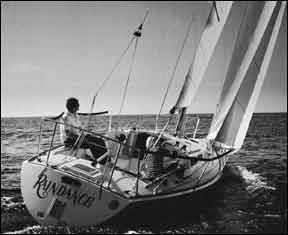
The joinerwork is above average and all of the bulkhead and furniture tabbing is extremely neat. There isn’t much to the Olson 30’s interior, but what there is has been done with commendable craftsmanship. The interior wood is fragile, though. There are several unsupported panels of the 3/8″ plywood; if someone were to fall against them with much force it’s likely they would fracture. The cabin sole is narrow, and with the lack of headroom the woodwork is especially susceptible to being dinged and scratched from equipment like outboard engines. Once the finish on the wood is broken, it quickly absorbs water, which collects in the shallow bilge.
The Olson 30 is not a comfortable cruiser. Even after you’ve taken all the racing sails ashore, the belowdecks is barely habitable. To save weight the quarterberths are made of thin cushions sewn to vinyl and hung from pipes. These pipe berths are comfortable, but the cushions are not easily removed. Should they get wet it’s likely they would stay wet for quite a while. Two seabags are hung on sail tracks above the quarter berths, which should help to insure that some clothes always stay dry.
Just forward of each quarterberth is a small uncushioned seat locker. Behind each seat is a small portable ice cooler. In one seat locker is the stove, an Origo 3000 which slides up and out of the locker on tracks. The Origo is a top-of-the-line unpressurized alcohol stove, but to operate it the cook must kneel on the cabin sole. To work at the navigation station, which is in front of the starboard seat, you must sit sideways. In front of the port seat is the lavette, with a hand water pump and a removable, shallow drainless sink. Drainless sinks eliminate the need for a through-hull fitting, a good idea; but they should be deep, not shallow.
The portable head is mounted under the forward V-berth, which we think is totally unsuitable for a sailboat. Who wants a smelly toilet under his pillow? Although there are curtains which can be drawn across the V-berth, we think human dignity deserves an enclosed head, especially on a 30′ boat. The Vberth is large and easy to climb into, but there are no shelves above it nor a storage locker in the empty bow. In short, if you plan to cruise for more than a weekend you had better like roughing it.
Conclusions
For 30-footers, the price of an Olson 30 is cheap; but for boats of similar displacement, it’s damned expensive.
What do you get for the money? You get a boat that is well-built, seaworthy, and reasonably well laid out. You get a boat that, in light air, will sail as fast as boats costing nearly twice as much. Downwind in heavy air, you have a creature that will blow your mind and leave everything shy of a bigger ULDB in your wake. If you spend all of your sailing time racing in a PHRF fleet in an area where light or heavy air dominates, the Olson 30 will probably give you more pleasure for your dollar than almost anything afloat.
However if you race often in moderate air or enjoy more than a very occasional short cruise, you are likely to be very disappointed. Before you consider the Olson 30, you must realistically evaluate your abilities as a sailor. There’s nothing worse than, after finding out that you can’t race a boat to her potential, knowing that she is of little use for the other aspects of our sport.
RELATED ARTICLES MORE FROM AUTHOR
Leave a reply cancel reply.
Log in to leave a comment
Latest Videos

Cabo Rico 34 Boat Review

Super Shallow Draft Sailboat: The Leeboard Sharpie

Hans Christian 41T – Boat Review

Seven dead after superyacht sinks off Sicily. Was the crew at...
Latest sailboat review.

- Privacy Policy
- Do Not Sell My Personal Information
- Online Account Activation
- Privacy Manager
Visit our Popular Forums
- Monohull Sailboats
- Multihull Sailboats
- Powered Boats
- General Sailing
- Antares Yachts
- Fountaine Pajot
- Lagoon Catamarans
Cruising Business
- Boat Classifieds
- General Classifieds
- Crew Positions
- Commercial Posts
- Vendor Spotlight
Life Aboard a Boat
- Provisioning: Food & Drink
- Families, Kids, & Pets Afloat
- Recreation, Entertainment, & Fun
- Boat Ownership & Making a Living
- Liveaboard's Forum
Seamanship, Navigation & Boat Handling
- Seamanship & Boat Handling
- Training, Licensing, & Certification
- Health, Safety, & Related Gear
- Rules of the Road, Regulations, & Red Tape
Engineering & Systems
- Const. / Maint. / Refit
- Product / Service Reviews
- Electronics: Comms / AV
- Electrical: Batts / Gen / Solar
- Lithium Power Systems
- Engines & Propulsion
- Propellers & Drive Systems
- Plumbing / Fixtures
- Deck Hdw: Rigging / Sails
- Aux. Equipment & Dinghy
- Anchoring & Mooring
Photo Categories
- Member Galleries
- Life Onboard
- Sailing in the Wind
- Power Boats
- Cruising Destinations
- Maint. & Boat Building
- Marine Life
- Scuba Diving & Divers
- General Photos
Recent Photos

Listing Categories
- African Cats
- view more »
- Crew Wanted
- Crew Available
- Enhance Your Account
- Meet the Mods
- Meet the Advisors
- Signup for The Daily Cruiser Email

IMAGES
VIDEO
COMMENTS
Posts: 1,167. Pacific 30. I put a skeg on my first boat in New Zealand , a 36 ft cement boat. I ran the leading edge pipe (1 1/2 inch sch 40 pipe) and the trailing edge pipe ( 2 inch sch 40 pipe)thru the hull, the trailing edge pipe up thru the deck and bolted to a bulkhead , and the leading edge pipe up and bolted to the cockpit floor.
It takes into consideration "reported" sail area, displacement and length at waterline. The higher the number the faster speed prediction for the boat. A cat with a number 0.6 is likely to sail 6kts in 10kts wind, a cat with a number of 0.7 is likely to sail at 7kts in 10kts wind. KSP = (Lwl*SA÷D)^0.5*0.5
The Pacific 30 is equipped with a fin keel. A boat with a fin keel is more manoeuvrable but has less directional stability than a similar boat with a long keel. The keel is made of lead. Compared with iron, lead has the advantage of being 44% heavier, which allows a smaller keel and hence less water resistance and higher speed.
Here are the boats Kretschmer suggests: Contessa 32, Pacific Seacraft 34, Pretorien 35, Cape Dory/Robinhood 36, Valiant/Esprit 37, Prout Snowgoose 37, Alajuela 38, Privelege 39, Freya 39, Passport 40, Caliber 40, Baba 40, Hallberg Rassy 42, Taswell 43, Hylas 44, Norseman 447, Beneteau 456, Outbound 44, Hylas 46, Kaufman 47, Tayana 48, Hylas 49 ...
The engine controls are all within easy reach of the helm. This particular 31 is fitted with an in-mast furling mainsail, giving the boat a working sailplan of 485 square feet. With the full main and headsail close-hauled, and the wind between 10 and 14 knots, the 31 slid along through a 1-foot chop at 3.6 knots.
The Pearson 30 has a well-proportioned masthead rig. The mainsail comprises 44% of the working sail area, more than is found on many modern "racercruisers," but a reasonable proportion for a true multi-purpose boat. Base price in 1971 was $11,750. By November 1979, base price had jumped to $28,300.
Pacific 30 is a 29′ 11″ / 9.1 m monohull sailboat designed by Raymond Richards and built by J D Marine (CAN) starting in 1962. ... The lower a boat's ratio is, the less power it takes to drive the boat to its nominal hull speed or beyond. Read more. Formula. D/L = (D ÷ 2240) ÷ (0.01 x LWL)³ D: Displacement of the boat in pounds. LWL ...
The Pacific 30 is a 30.0ft masthead sloop designed by Ray Richards and built in fiberglass since 1962. The Pacific 30 is a heavy sailboat which is under powered. It is very stable / stiff and has an excellent righting capability if capsized. It is best suited as a bluewater cruising boat. The fuel capacity is originally very small.
The Pacific Seacraft 34 is perfect for a cruising couple. John Kretschmer is a delivery captain, adventurer and writer, whose own boat Quetzal, a 1987 Kaufman 47, has seen a refit or two over the years. His latest book is Sailing a Serious Ocean: Sailboats, Storms, Stories and Lessons Learned from 30 Years at Sea, also available on his website.
2. Ericson 27. r32_damax. The Ericson 27 debuted in 1971 with a displacement of 6,600 pounds and plenty of stability in the masthead sloop. The boat is roughly 27 feet long and sits about four feet in the water. Many love this design since it navigated through choppy waters and responded to wind changes well.
The newer PSC 31 which has a skeg-hung rudder, with space between it and the keel. This space makes me believe that the boat would behave better in reverse, but I've never sailed a 31 and never some advice. Otherwise, I'd probably be looking at an Island Pacific 32 (or 31). Reply Like.
Here are the best liveaboard sailboats for bluewater cruising. 1. Pacific Seacraft Flicka 20. cdmech. The Flicka 20 is the smallest and most interesting sailboat on our list. At only 20 feet overall in length, the interior accommodations of this vessel are spartan at best and suitable for minimalist living.
Bavaria 38E Alamitos Bay. Jun 4, 2020. #13. I personally doubt that you will much enjoy sailing west to east in the Caribbean on a beamy, 30-ft boat built for the Newport to Catalina run across a 26 n.mi. channel. Boats sailing the Caribbean these days tend to be nearer 40 ft, often larger.
Sailboat Reviews; Sailboats 21-30ft; Flicka ... as was another attempt to produce the boat in ferro-cement. Pacific Seacraft acquired the molds in 1978 and, with only minor changes, the boat as built by Seacraft remained the same until 1983, when a new deck mold was tooled to replace the worn-out original. ... a noble endeavor that gives an ...
The boat tracks well and rarely takes any water over the bow or into the cockpit. In higher winds, the heeling effect makes steering from the inside helm station difficult on port tack. The pilothouse is at its best in quieter seas, on long treks, and at anchor. It's difficult to fault the Rawson PH 30 within its limitations.
I'm sure a large-boat owner can easily rationalize their boat-buying decision. But for us, on board our little First Light, we're happy being the smallest boat in port. Photos and story by Paula VanEnwyck-Christie. Paula Vanenwyck-Christie and her husband, Brian, have sailed for more than 30 years in California, Mexico and the Pacific ...
ramminjammin said: I bought a 1975 tartan 30 last October. Hull number 298. The boat is solid to sail very stable. I am inexperienced , I had this boat doing 21 knots sailing her from Grand Manan to Nova Scotia when I bought her last fall ! And the second fastest GPS speed on a different day was 19 Knots !!!
The Pacific 30 is equipped with a finn keel. A boat with a fin keel is more manoeuvrable but has less directional stability than a similar boat with a long keel. The keel is made of lead. Compared with iron, lead has the advantage of being 44% heavier, which allows a smaller keel and hence less water resistance and higher speed.
30. Swan 44. A strong, robust cruising boat built for high-seas, blue water adventures, the Swan 44 was designed by Sparkman & Stephens, and the yacht's well-known Finnish manufacturers, Nautor Swan, produced 76 boats in a production run that lasted from 1972-1975.
Sailboat Reviews; Pacific Seacraft 34 and 37 ... He sails a Sparkman & Stephens-designed Yankee 30 out of St. Petersburg, Florida. You can reach him at darrellnicholson.com. RELATED ARTICLES MORE FROM AUTHOR. Blue Jacket 40 Used Boat Review. Catalina 270 vs. The Beneteau First 265 Used Boat Match-Up.
The First 30 is 10.33 metres long and has a displacement of 3,150 kg, meaning that even small crews can enjoy quick easy planing.. Planing is that magical moment when, at full speed, your yacht's hull lifts and is in limited contact with the water, minimising friction and creating a smooth, gliding sensation.
capta. 10197 posts · Joined 2011. #2 · Aug 29, 2018. Joshua Slocum's Spray was 36-foot-9-inches long. About 14 sub-40 footers are presently racing around the world single-handed, nonstop. Check out the Mini Transat 6.50 if you want to see even smaller boats crossing the Atlantic. You don't need a 40 plus footer to cross oceans any more than ...
Sailboat Reviews; Sailboats 21-30ft; Olson 30 This speedster is as specialized as it gets; mind-blowing performance, but almost no living space. ... The first project for Pacific Boats was the Olson 30, which was put into production in 1978. Pacific Boats later became Olson/Ericson, and produced a 25 and a 40. The latest incarnation of the 30 ...
Both my partner and I are planing to sail through the pacific. We are looking for boat around the 30ft mark and due to finance restraints (35-40K) the boat would be in the 1980-85 year range. We would be sailing up from Sydney Australia and plan on spending at least one to two years sailing. Can anyone suggest any appropriate brand and styles of boat I should look for.